July 2025 News

On 19 June CMR's BB 67614/67613 are captured in the cutting at Chalmaison on Ligne 4 with a pair of VB 2N coaches en route from Sotteville to Romilly-sur-Seine for 'deconstruction'. The windows and presumably other re-usable components have already been removed.
Photo: Jean-Louis Poggi.
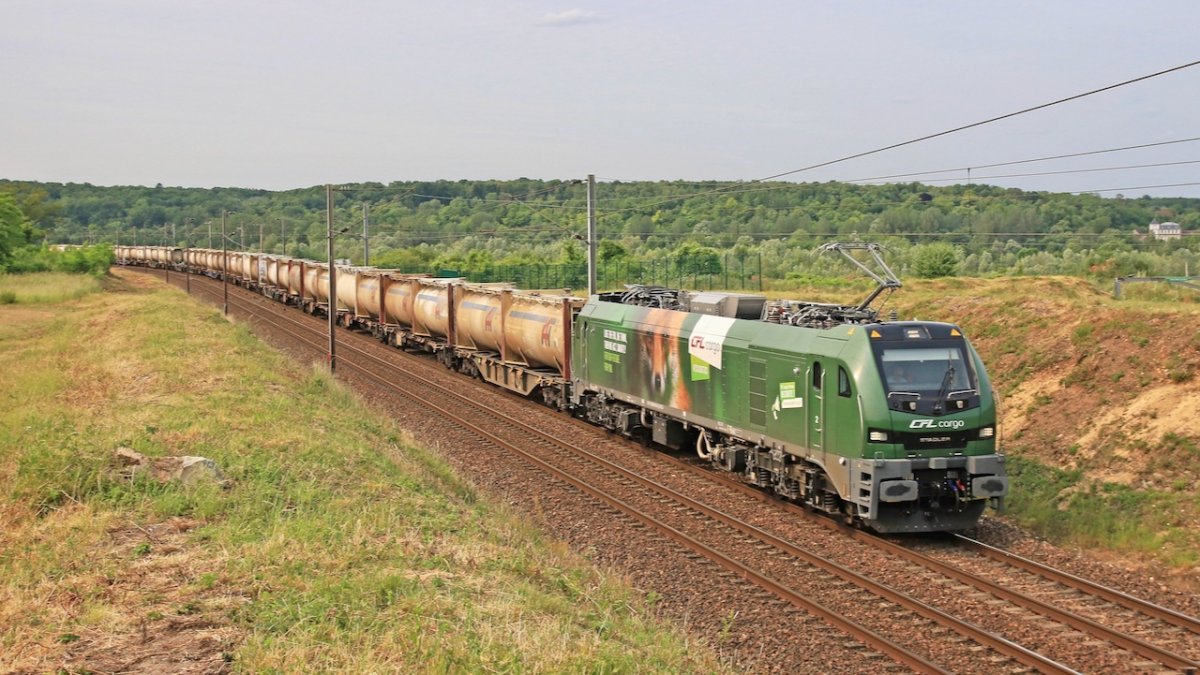
The latest locomotives to appear on the French network are Stadler E 6000s. A member of CFL Cargo's small fleet of five seen having just crossed the Marne at Changis Saint-Jean on the evening of 3 June hauling a trainload of containerised cement from Valenton to Bettembourg, whence it will proceed to Esch-sur-Alzette. Photo: Christophe Masse.
Stadler’s E 6000 is a three-system Co-Co electric locomotive developing 6,170kW (8,400 bhp) with 25kV AC and 3kV DC, and 4,100kW (5,600 bhp) with 1.5kV systems. Normal operating speed is 120km/h although it is designed to operate at up to 160km/h. It is equipped with regenerative braking and a hybrid coupler suitable for both manual and automatic coupling.
Lightweight developments
Inauguration of its innovations vitrine (shopwindow) on 23 May marked the start of building work at the Ferrocampus site in Saintes. Over 50 partners are working with Nouvelle-Aquitaine région to develop this research and training centre for decarbonisation of rail transport. The first two projects aim to cut the operating and maintenance costs of rural railways by harnessing new technology for lightweight vehicles and simplified control systems. Nouvelle-Aquitaine plans to eliminate diesel traction by 2035. As well as hybrid, hydrogen and battery, the région has looked at natural-gas power. Studies have confirmed the technical feasibility of converting X 73500 railcars to bioVNB, methane produced from domestic, industrial and agricultural waste.
Star of the show was the first bodyshell of the Telli railcar recently arrived from CAF. Telli is being developed by SNCF and 10 partners, with €37 million of the €89 million cost provided by Ademe, the State environmental transition agency, under the France 2030 programme. Telli is the most ‘conventional’ of the lightweight rolling stock designs, whilst meeting Ademe’s criteria for decarbonisation. It looks like a classic railcar and is intended to replace stock such as X 73500 on short to medium-distance branches and feeder routes, though up to four cars can run in multiple. Photos: La Tribune Bordeaux/FEG and Sud Ouest/AL.
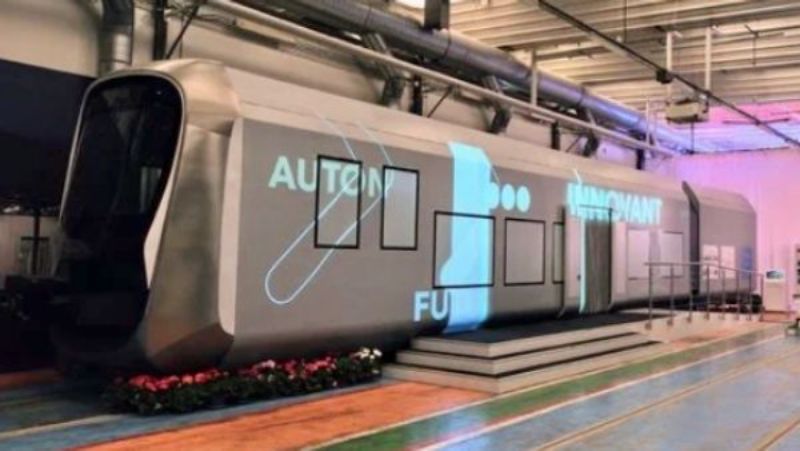
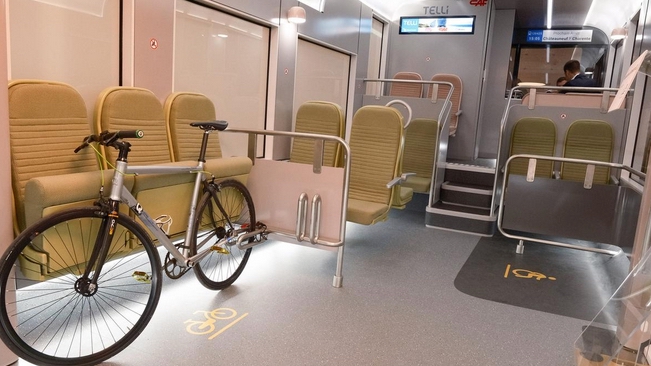
Of modular construction and at 40 tonnes around 30% lighter than today’s MU cars, Telli is battery-powered with a range of 200km; it can also take current at 1.5 or 25kV from OHL. Maximum speed is 120km/h. Independent wheels and individual suspension dispense with much of the weight of normal bogies, reducing wear-and-tear on the track. Telli is compatible with existing signalling, though digital control is being developed. There is seating for 70 passengers. Construction cost has been estimated at around €5 million ‘per train’.
In-service trials continue of Telli’s components and systems mounted in laboratory railcar X 73525 working routes out of Limoges. Under test in May was the obstacle detection system developed by Hitachi. Photo: France Télévisions.
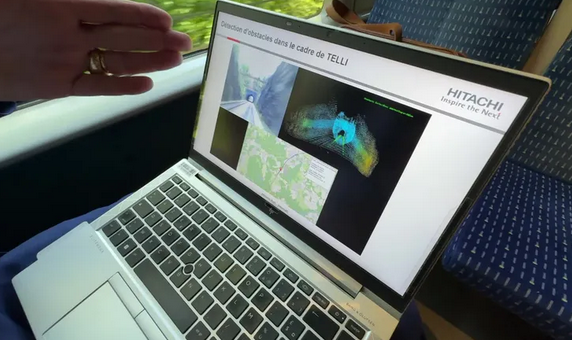
Of the other light railcar projects supported by France 2030, prototypes are awaited for Draisy (seats 30) and Flexy (road/rail, seats 14), both of which had been expected to start trials this year. The 14km closed line between Étang-sur-Arroux and Autun in Bourgogne-Franche-Comté will be the showcase for trials of Flexy (see August 2024 News), now expected in 2027. Flexy is based on a Renault Master van and designed to revitalise lines either already closed or which have too few passengers for economic operation by conventional railcars. The vehicle runs at up to 70km/h on rail and can leave the track at level crossings to serve town centres and other nodes instead of stations that may be some distance away.
Draisy has been running trials at Lohr’s plant at Duppigheim in Bas-Rhin département; test results are expected shortly and a prototype should be ready in 2027. Pre-commercial trials will use the 8km Sarralbe – Kalhausen line in Grand Est, closed in 2018. Once regulatory approval is granted and operating rules established, Draisy is planned to enter service on the Sarreguemines – Bitche – Niederbronn line (64km), reopening of which is a long-term aim of Grand Est région.
Another car making its debut is Ecotrain, under development by Socofer, Stratiforme and partners since 2019, and also benefiting from Ademe funding. A prototype carbody was unveiled at Stratiforme’s plant at Bersée south of Lille on 26 May. At 14m length, it is more like a railbus and its looks recall cars developed for metre-gauge lines in the 1930s. Ecotrain is intended for economical operation of short lines currently out of service. Using composite technology developed by Stratiforme for production of MU and tramcar front ends, the car will be battery-powered, recharging from a microvoltaic power plant, with a range of about 50km.
Photo: Stratiforme Industries.
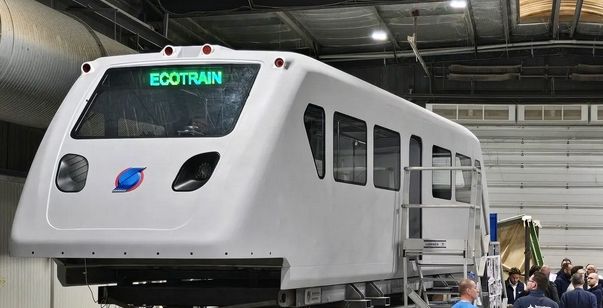

Services to Modane on the French-Italian border were restored earlier this year after a cliff fall caused by unprecedented rain closed the line for 18 months, one of the many climate-related events faced by SNCF. On Saturday 7 June TGV Réseau 4501 (one of six members of the class equipped to operate in Italy under 3kV DC) waits to depart with TGV 9243 Paris Gare de Lyon – Milano Porta Garibaldi. On the opposite platform, CC 6549 has arrived from Chambéry with a railtour organised by AMPFS. Photo: Pierre Julien.
SNCF needs an extra €1 billion
France’s 17,000km ‘core network’ that carries 90% of traffic is not in such poor condition as Germany’s, but average age of track is 30 years and much electrification equipment is even older. Unless additional funding is allocated, around 4,000km will be vulnerable to speed restrictions and temporary closures between 2028 and 2030, while a further 10,000km will be at risk in the following decade if work cannot be stepped up. Note that these are the country’s busiest main lines, not the dessertes fines rural routes that are also suffering from lack of resources.
Under its current performance contract, SNCF finances €3 billion annually for renewals from access charges and internal sources (profits mainly from international business, consulting and road transport). But this sum has not been sufficient due to inflationary pressures and unprecedented weather events related to climate change. As a result, in 2023 the government recognised the need for a €1.5 billion increase from 2027, which SNCF and independent assessors agree is the minimum required.
From 2028, SNCF will be able to raise a further €500 million from its own resources, the maximum possible without endangering the group’s finances. Thus an extra €1 billion remains to be found urgently, and it is to AFT that SNCF is looking for a solution. Amongst possible new funding sources suggested, the commission looked at:
● A dedicated share of the €5 billion likely to be available to France under the EC carbon-emission quota trading system.
● A new road toll or tax income to be levied as motorway concessions come up for renewal between 2031 and 2036.
● A tax on ticket purchases.
● Extending the EC energy-saving certification scheme to include railways.
● Revival of the unpopular heavy goods vehicle eco-tax.
AFT’s four working sessions will end in early July. The tight schedule was necessary in part because of the long lead time required by SNCF to plan and programme works for 2028 and beyond. SNCF described AFT as a ‘unique opportunity’ to find solutions to long-term funding needs with ‘all options under consideration’ to secure the future stability of the rail network.
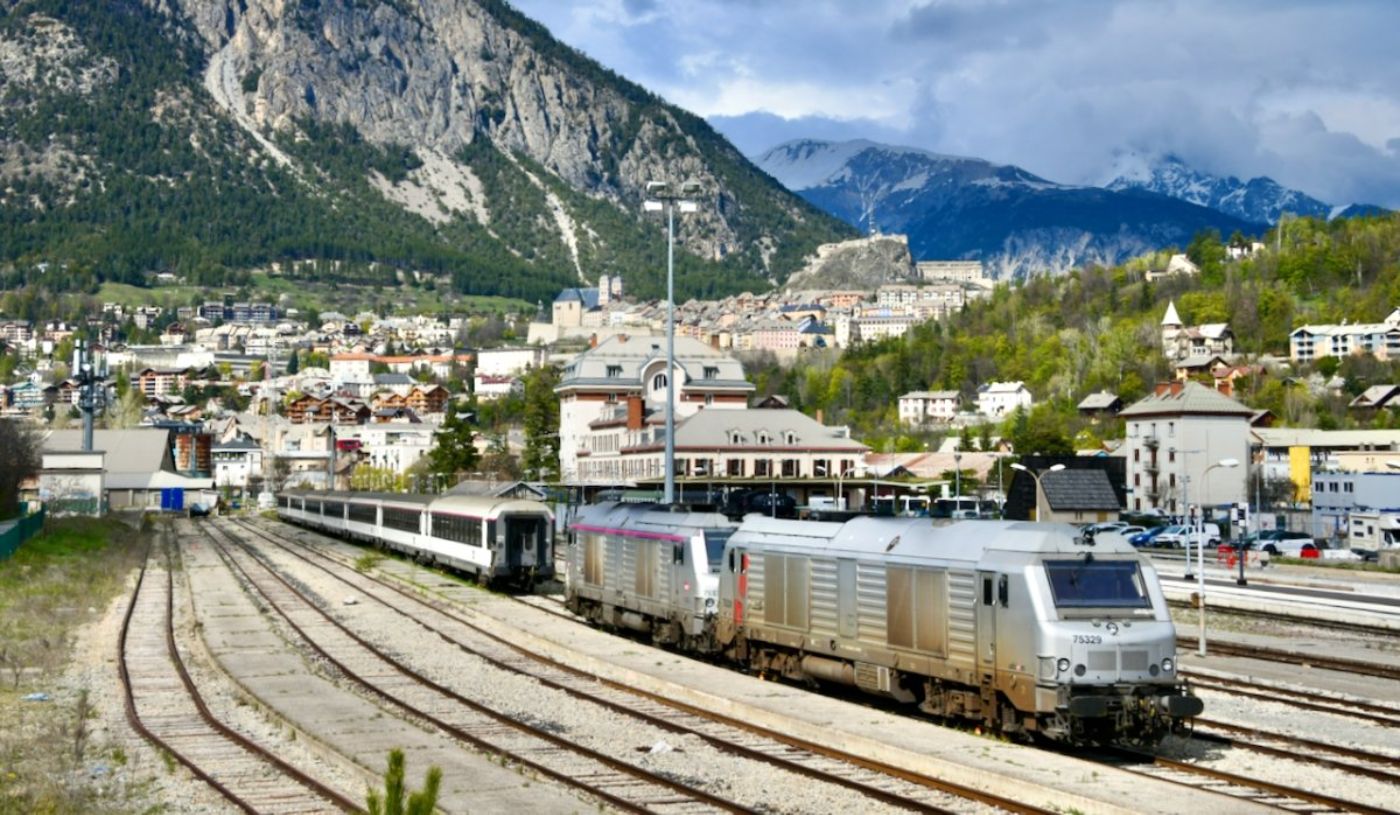
During a sunny interval on the afternoon of 26 April, BB 75329/75333 wait at Briançon with the stock of the overnight service to Paris ICN 5790 at 19.57.Photo: Didier Delattre.
In June members of parliament representing the Hautes-Alpes and Drôme regions wrote to the President of SNCF denouncing the extent of cancellations to the Briançon overnight service from July until next year due to engineering work. In September it will run on only six nights, five nights in each of October and November, and not at all in December. They consider SNCF's arguments disproportionate and that the failure to find an alternative rail solution to foreseeable disruption in breach of the Intercités funding convention between the state and SNCF. Historically the train has been diverted via the Hautes Alpes line between Aspres-sur-Buech and Grenoble.
Patronage of the four IC Night trains (eight destinations) increased by 26% in 2024 to just over a million journeys. Average occupancy is 76%, with the fleet of 129 refurbished cars nearing maximum utilisation.
Nox night network
For France, Nox proposes Paris to Barcelona, Nice, Munich and Vienna, a Brussels – Barcelona service via Lyon, and Amsterdam – Toulouse. The routes have been chosen to avoid multiple border crossings, covering 500 to 1,500km with journey time not exceeding 12h. Photos: Nox.
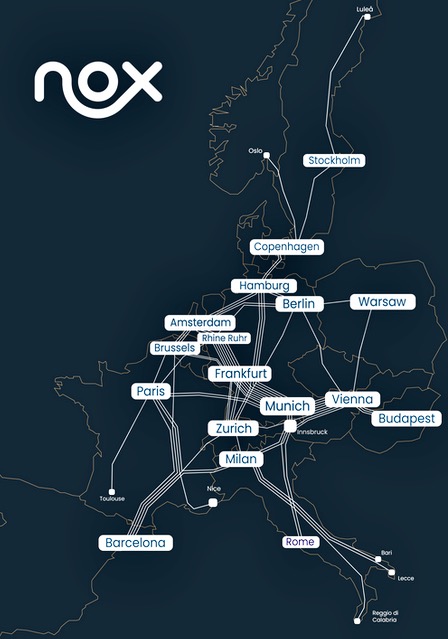
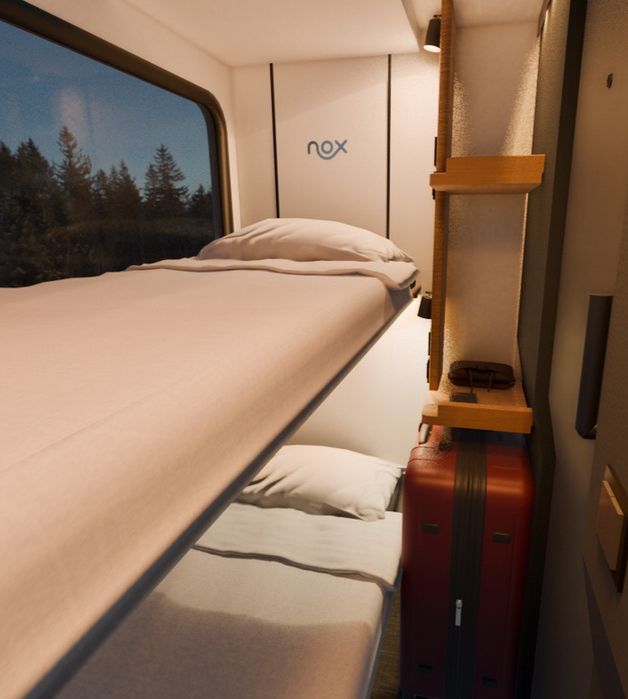
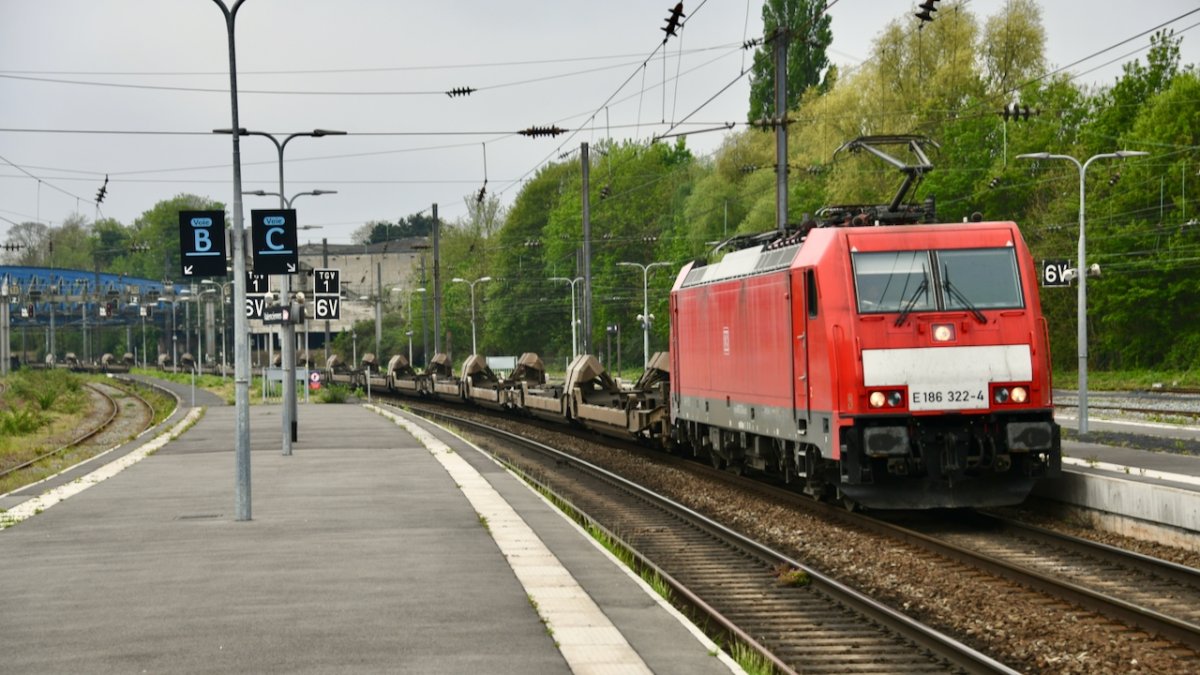
DB Cargo Traxx 186 322 heads through Valenciennes on the 22 April with an empty 52924 Le Boulou – Calais.
Photo: Didier Delattre.
Calais aims to double piggyback traffic
Boulogne-Calais Port Authority (PBC) would like to see a doubling of this traffic in the next five years, arguing that one-third of lorry traffic on VIIA’s piggyback services is to or from Calais. In particular, the Sète service is expected to be boosted from three to five train pairs a week after a dedicated terminal there opens later this year, while the Le Boulou service will grow from 9 to12 trains a week and Macôn from three to five. PBC and VIIA are studying the possibility of launching a service between Calais and eastern Europe. VIIA also hopes to increase train length; on other routes this has been pushed from 750m to 850m.
This traffic does not include that carried by the Cargobeamer service from Beau Marais (around 5km from Calais and therefore outside the port area) to Perpignan, currently operating four times a week with traction again by DB Cargo. In 2021 Cargobeamer launched a service to Domodossola in Italy, then suspended it in 2023 and has currently no plans for a relaunch. VIIA operated a service to Turin Orbassano until 2022 and also has no current plans to relaunch the route.
€20 million is being invested to equip the Sète terminal for loading semi-trailers horizontally using Modalohr technology, rather than craning them onto flat wagons, the trailers sliding into position on a pivoting cradle. Photos: Port de Sète.
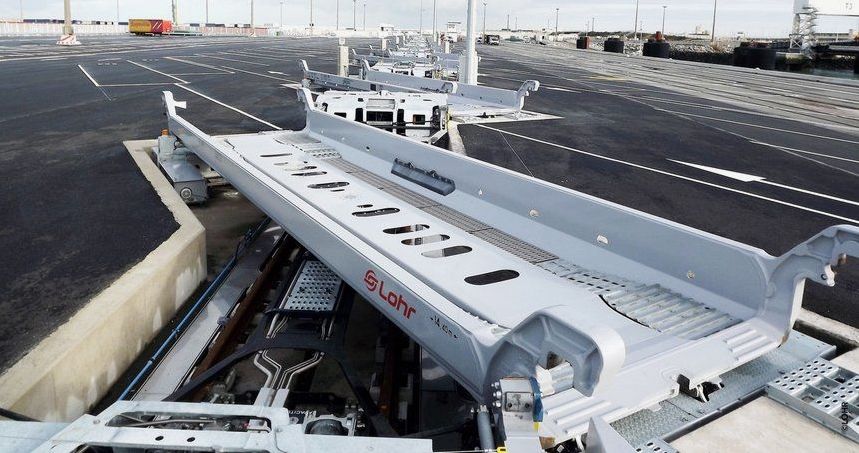
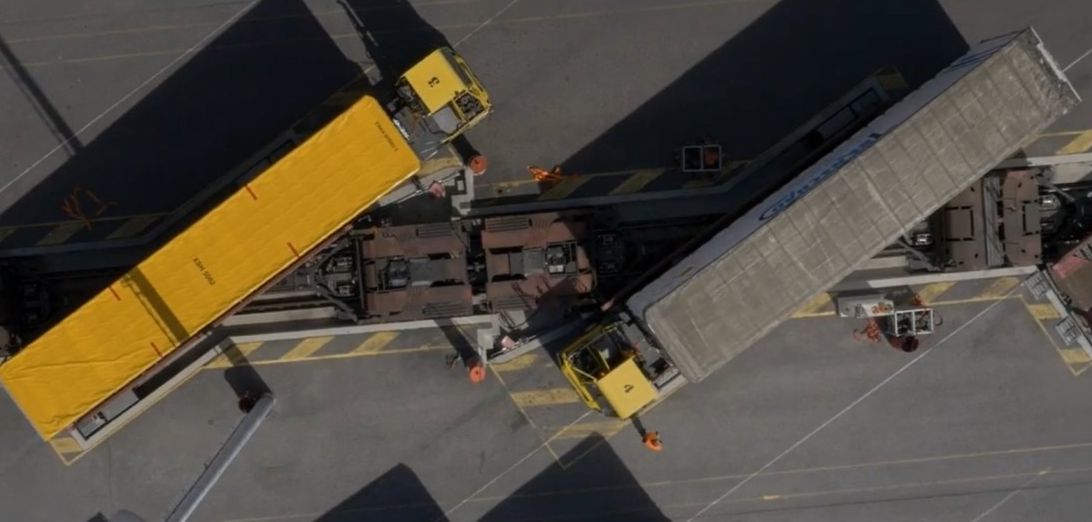
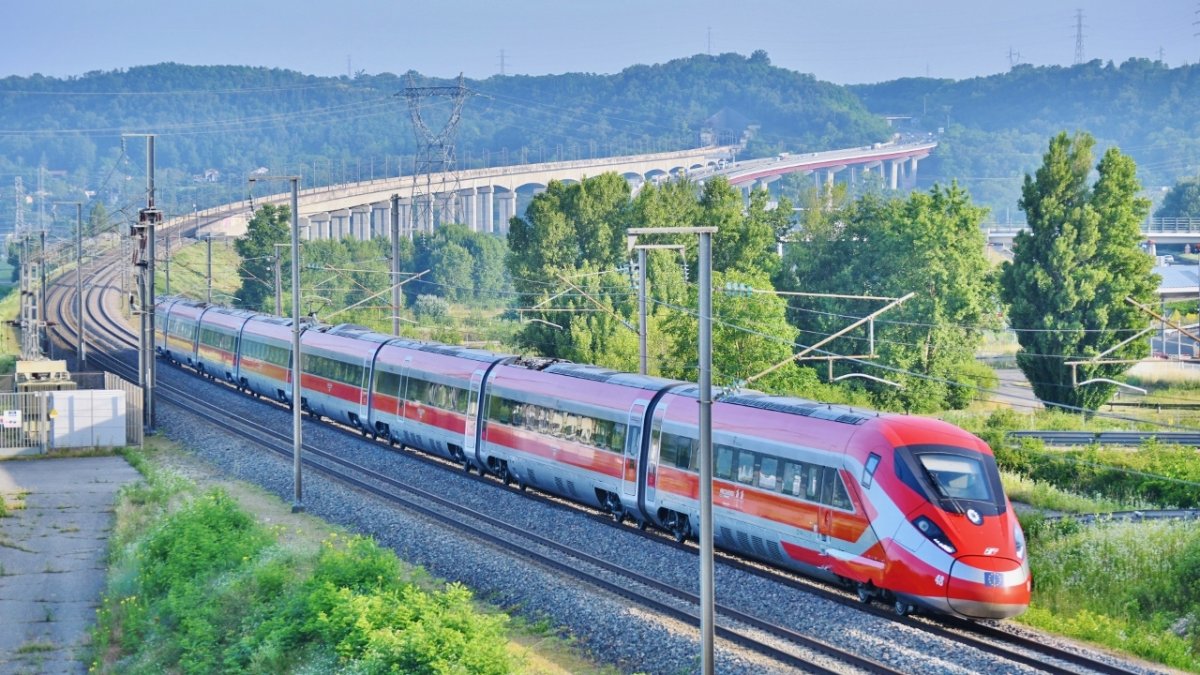
Trenitalia introduced their Paris - Marseille service on Sunday 15 June. The new service is operated using Frecciarossa high speed units with intermediate stops at Lyon St-Exupéry, Avignon TGV and Aix-en-Provence TGV. There are four return services a day covering Paris to Marseille in three and a half hours. Tickets are sold on a capacity management basis starting at €27 single from Paris to Marseille. On the Friday preceeding the launch a press special was laid on. Running as Train 794493 it is seen coming off the 1725m Viaduc de la Côtière Beynost, east of Lyon. Photo: Pierre Julien.
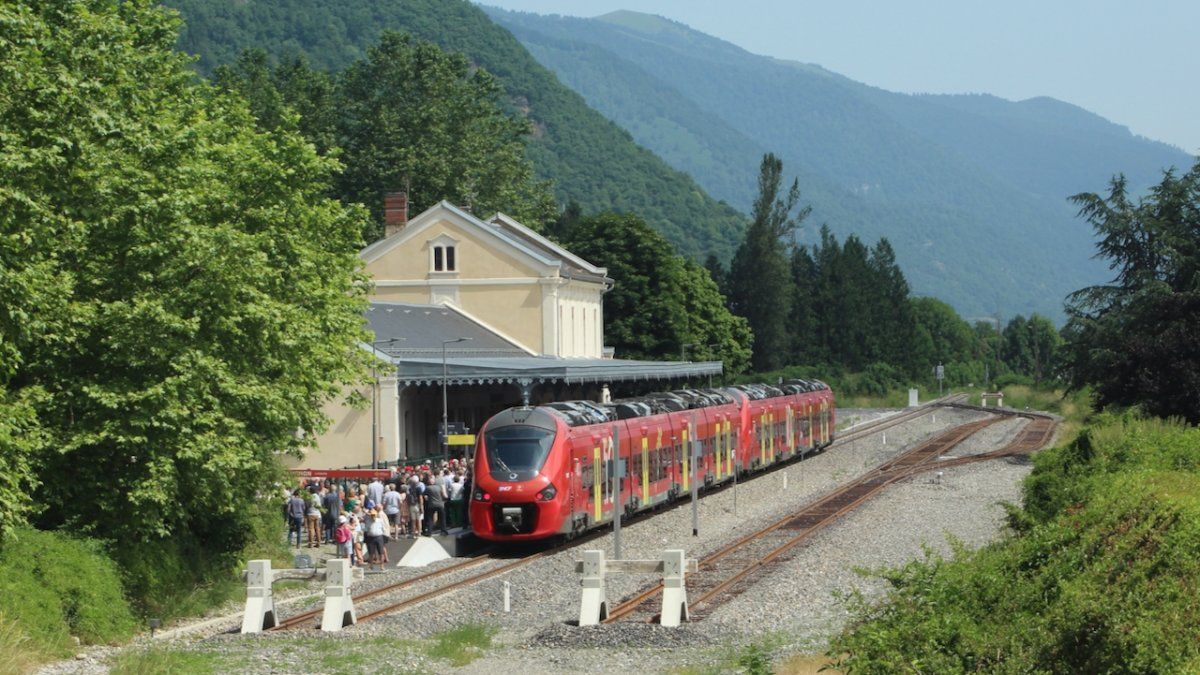
Régiolis B 83595/96 heads the inaugural train at Luchon on 22 June. To the right of the platform line is the short loop that will just accommodate a four-car unit or a small engineers’ train. Photo: Georges Turpin.
Reine des Pyrénées welcomes trains again
Mme Delga felt “pride and emotion” she said in an interview, reminding visitors she had promised 10 years ago that the line would be reopened. Transfer of the railway from SNCF Réseau had been a national first. Rebuilt at a cost of €69 million,100% financed by Occitanie, the line extends the région’s commitment to employment opportunity, decarbonisation and disenclavement (opening up), at a time when climate change is jeopardising the future of winter sports resorts. She also highlighted her new battle against the threat to Occitanie’s rural lines in the current financial climate, under the banner Petites lignes, Grand cause.
Public service started the following day with six A/R (times shown in last month’s News); trains call intermediately at Marignac-Saint-Béat, Saléchan-Siradan and Loures-Barbazan. The first train runs through from and to Toulouse, bringing a fresh MU to the service each day, following refuelling at Rodez (see below). There is no passing loop on the 36km line; one train operation is in force with occupation verified by axlecounters at Montréjeau. In exceptional circumstances, a second train (such as an excursion) can be locked into the short loop at Luchon.

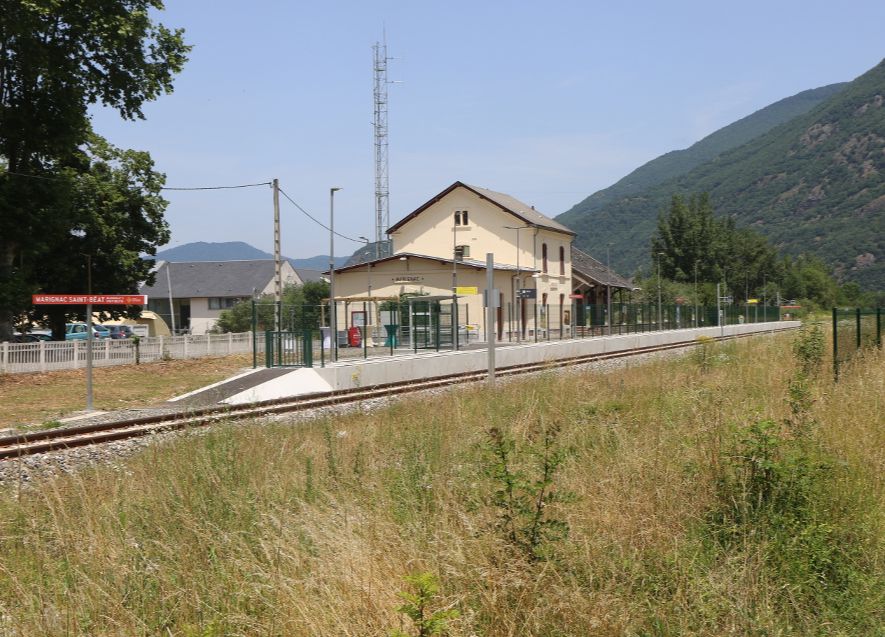
Above. Left The new Saléchan-Siradan station, rebuilt to be closer to Saléchan. The old station is visible in the distance on the right. Right. Marignac station, now reduced to one track with the connection to Pont du Roy and the metre gauge line from Marignac to Val d'Aran (MVA) long gone. Photos: Georges Turpin.
The seven daily buses continue to run; their usage will be reviewed after six months. Offers are available to try the train service for €1 or €3, though local passengers may balk at paying the full €6.40 fare to use the train instead of the bus at €2. At Luchon, it is hoped that transport can be provided to take rail passengers the last kilometre to the town centre or their hotels; walking is problematic because of the traffic and deteriorated pavements.
Located at 630m altitude, the thermal and ski resort in Haute-Garonne département is just 8km from the Spanish border. Known as ‘Queen of the Pyrénées’ for its superb position and leisure facilities, Luchon lost its vestigial service (including a night train from Paris) in 2014 after bad weather caused severe damage to the infrastructure. It was the last of CF du Midi’s branches into the Pyrénées to retain electric traction, introduced in 1925; the OHE has not been restored for the reopening.
This is likely to be the last for some time of Occitanie’s planned reopenings. Even before the current budget cuts, revival of the Alès – Bessèges line had been postponed by four years to 2028, whilst Limoux to Quillan and Rodez – Sévérac-le-Château were both ‘paused’ last year when the financial crisis hit.
Transdev takes over Nice – Marseille
On 29 June Transdev took over operation of the Nice – Toulon – Marseille service on behalf of Sud TER, the first major TER concession to be run by a private operator.
The service was previously operated by SNCF Voyageurs using BB 22200s and Corail stock, the honour of hauling the final Nice – Marseille service falling to BB 22309 on the evening of 28 June.
16 Omneo Premiums were ordered from Alstom in November 2021 but late delivery of the full fleet has resulted in Transdev borrowing rolling stock from TERs. On 29 June Z 56209 is seen at Marseille Saint-Charles having arrived with TER 17472 08.25 from Nice; other services that day were noted in the hands of Grand Est Régiolis units. The former two-hourly service has become hourly.
Photo: ©Radio France/DP.
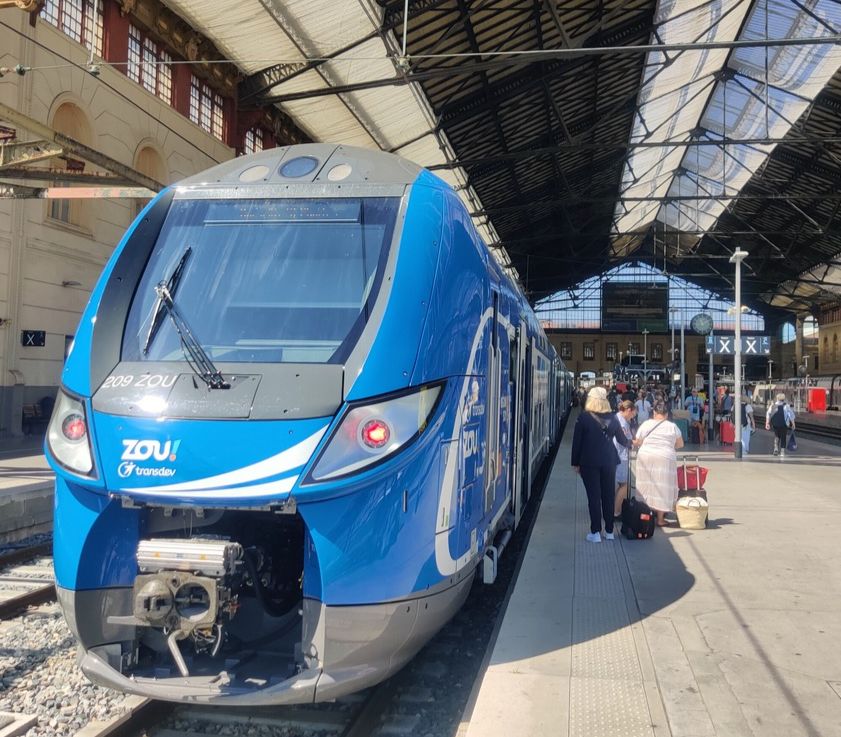
News in Brief
LGV. The Conseil d’État announced on 12 June that the Paris – Normandie LGV would not be included in the next Île-de-France Master Plan, effectively killing off the project, citing the high cost (€11 billion) and widespread opposition. However, transport minister Philippe Tabarot assured supporters in Normandie that “the dossier is far from being abandoned”. At the same time, a report in L’Humanité, based on a leaked government document, suggested that the Bordeaux – Toulouse and Provence Côte-d’Azur LGVs might be ‘reviewed’ as part of plans to cut €40 billion from next year’s budget. Nevertheless, the board of LNPA has agreed two funding packages: €545 million has been allocated to track capacity enhancements around Marseille (see January News) and €4.7 million for preliminary work on a depot at Avignon to maintain TGVs.
Ouigo. Is trialling a vente ambulante refreshment service over the summer in its upgraded trains on the Paris – Brest/Quimper routes, responding to a frequent complaint about lack of catering on the low-cost operation. The results will be assessed in September.
Lyria. Following introduction of its Première Signature business class in March, Lyria is to extend the operating period of its summer-season Marseille – Geneva – Lausanne service next year to run Thursday to Monday from April to October and every day in July and August.
Strasbourg. Three new TGV routes are running at weekends in July and August: to La Rochelle (TGV 5491/5492), Quimper (5474/5466) and Perpignan (5531/5532). The La Rochelle train runs A/R Saturdays and Sundays, whilst Quimper and Perpignan are served out Saturdays, return Sundays. The Perpignan train runs via Besançon Franche-Comté TGV, Dijon (reverse) and Chalon-sur-Saône.
Léman Express. SBB called tenders on 27 May for a new fleet of EMUs to expand capacity on the cross-border network in association with AURA région and the Swiss cantons of Geneva and Vaud. The initial contract would be for 25 trains with 40% more capacity than existing Régiolis and Flirt stock, plus options for a further 75 sets. A contract will be awarded in late 2026, with the first trains entering service in 2032. A new direct route from Annemasse to Geneva airport via the Châtelaine tunnel starts in December; it will be Line L7.
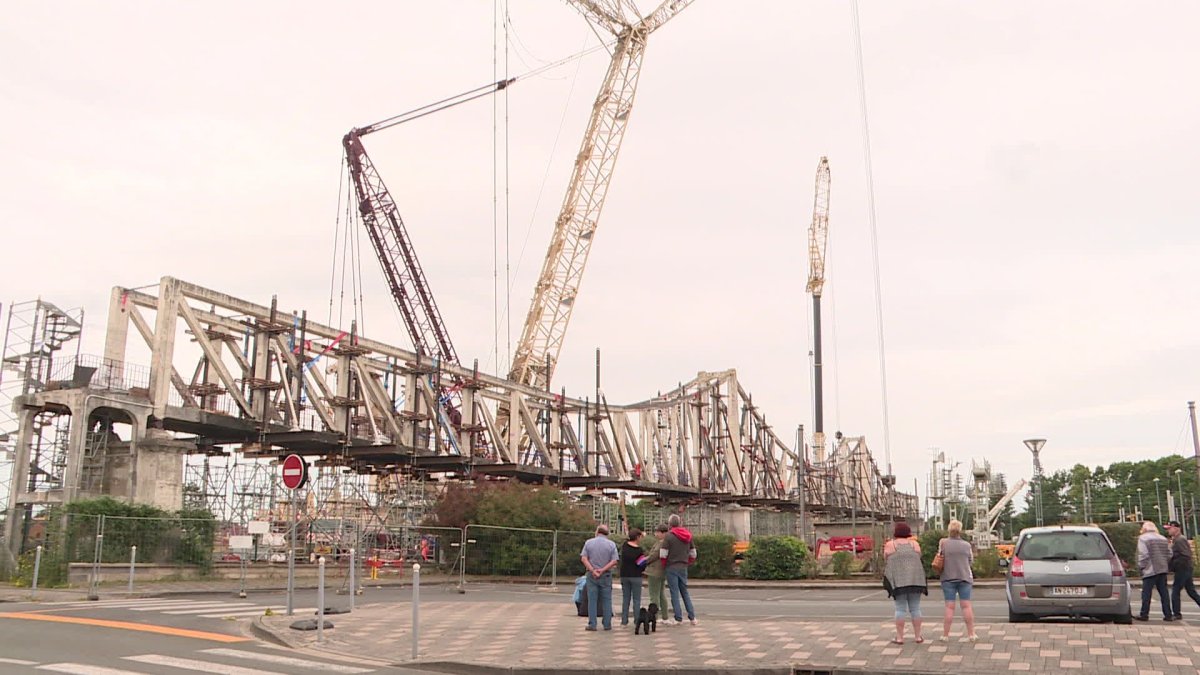
Tergnier. The 170m-long public footbridge across the tracks was dismantled last month, concluding a lengthy dispute between the commune and SNCF over responsibility for the crumbling concrete structure. SNCF paid the €9 million demolition bill but declines to help fund a replacement which could cost the town €16 million. Photo: France Télévisions/NS.
TER200. SBB starts work in November to enlarge the loading gauge between Saint-Louis and Basel (4.2km), part of the Four-Metre Corridor freight enhancement project. This includes the 1km Kannenfeld tunnel where the track will be lowered. The TER200 service from Strasbourg and Mulhouse to Basel will be reduced by up to 25% at times during the four-year works.
Épinal. The line to Lure is closed until 29 August whilst 13.5km of rail and 6,000 sleepers are replaced between Dounoux and Trémonzey.
Tonneins. After the washout on 19 May that closed the Bordeaux – Toulouse line at Tonneins (see June News), trains ran again from 28 May but limited to 40km/h over temporary track. It was 13 June before the line was cleared for full speed running. The washout caused a 2m deep cavity that required 160 lorryloads of rubble to fill and stabilise.
Occitanie. The région has allocated €5 million for platform renovation and construction in 2026 of an accessible footbridge at Villeneuve-lès-Avignon, the next station to be reopened on the Rive Droite route between Avignon and Pont-Saint-Esprit. €16.5 million funding has been approved for emergency engineering works over the next two years, including €4.2 million for the Cévenol route between Nîmes and Alès, and €0.5 million for emergency work to reopen the Perpignan – Villefranche Vernet-les-Bains throughout following last year’s incident at Eus.
Tours. The halt at Fondettes Saint-Cyr-sur-Loire on the Tours – Le Mans line will reopen with the December timetable change, fulfilling a long-standing local aspiration. Reconstruction will cost €1.7 million. Seven trains each way will call daily; journey time to Tours 10min.
High speed. France crept back into second place behind China in Railway Gazette International’'s 2025 world high speed survey published in the June issue. Thanks to a 1min cut in the fastest timing on LGV Est between Champagne-Ardenne and Lorraine TGV stations, TGV 5842 08.08 Nantes – Strasbourg covers the 167.6km in 37min at an average speed of 271.8km/h, just ahead of Japan’s best at 271.5km/h. SNCF’s second fastest is by Ouigo 7897 between Lyon Saint-Exupéry and Aix-en-Provence TGV, running the 289.4km in 64min averaging 271.3km/h.
Fares fair. Passengers on the French section of the Italian service from Ventimiglia (Vintimille) to Cuneo have seen their fares cut by up to half following adoption of per-km pricing instead of the ‘international’ tariff previously charged. Such tickets are not yet sold by French vending machines so passengers must pay on the train. Regular users will have the price difference refunded for journeys after 15 December 2024.

PACA signalling. SNCF Réseau’s new Marseille control centre was commissioned on 6 April. By 2040, it will have replaced 26 signalboxes with 70 staff controlling the entire Région Sud network stretching from Avignon to Vintimille. A crisis management room can be activated at any time in response to out-of-course events. Photo: France Bleu/FLD.
Brive. On 26 May SNCF Réseau announced a €3.4 million upgrade of the line from Brive to Ussel next year, with work concentrated on the Tulle – Meymac section which is still manually signalled. The same day, Nouvelle-Aquitaine région said that the secondary route from Brive to Limoges, closed between Objat and Saint-Yrieix-la-Perche since 2018, would not be reopened.
Douai – Cambrai. At the reopening on 2 June after 17 months’ closure for modernisation it was announced that the two-hourly service will become hourly from 1 January 2026.
Aubrac. The line was closed north of Bédarieux from 2 June until 4 July for renovation of earthworks and replacement of a bridge at Saint-Georges-de-Luzençon, SNCF Réseau financing the €500,000 cost. Trains could not run over the unaffected section north of Millau due to the lack of servicing facilities for EMUs.
Le Grau-du-Roi. Following incidents of overcrowding, Occitanie’s €1 ticket offer will subject to reservation from 7 July and trains strengthened. Last year, 114,000 journeys were made during the summer holidays. The timetable this summer is compromised by the inability to cross trains at Vauvert as the loop is out of use.
Pays de la Loire. Back in service is the first of 13 TER 2N NG sets undergoing mid-life modernisation at Saint-Pierre-des-Corps Technicentre at a cost of €55 million. Two sets per year will be turned out through to 2030. The work follows on from refurbishment of 21 Z 21500/21700 EMUs, the last of which should be completed in September.
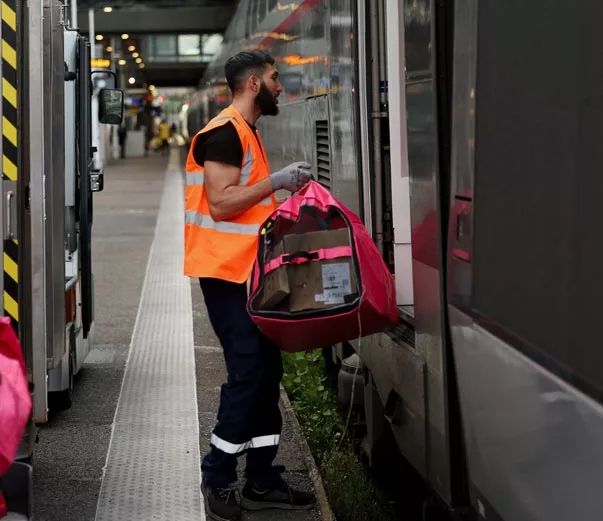
Parcels by rail. As reported last month, Rail Logistics Europe’s general freight arm Hexafret has launched a parcels service for Amazon conveying 500,000 items a year between depots in Lyon and Paris. The parcels are conveyed in dedicated holds in TGVs, covering the 472 km in just over two hours. Amazon is also using the Le Boulou – Bettembourg and Le Boulou – Calais intermodal services operated by RLE subsidiary VIIA, making rail a key part of its overall logistics strategy. Photo: SNCF Voyageurs.
RER. Transilien is again accepting deliveries from Alstom of NG trains for Line E after several weeks’ pause. Higher than expected incidence of breakdowns, twice the contracted rate and four times that of the current stock, appears to have been caused by wheel slippage. Alstom has a new order for a further 96 NG trainsets destined for Line D, bringing the total to 262 (130 for Line E and 132 for Line D). This latest batch will cost €1.7 billion.
Nouvelle-Aquitaine. Saw a 7.4% rise in TER journeys during 2024, star performers being Tours – Poitiers (up 28%) and Poitiers – Angoulême (up 29%). Bordeaux – Agen journeys rose 9.3% to almost 10,000 daily, with even some off-peak trains full. Two additional services will be added in December and certain trains lengthened as new Régiolis 2N EMUs are delivered. Also from December, the Modalis app currently deployed for bus ticketing will be extended to rail journeys.
Les Aubrais. On 28 May SNCF Réseau opened a new depot at Fleury-les-Aubrais. Initially serving this summer’s relaying of 70km of track between Les Aubrais and Boisseaux, part of the POLT upgrade, the site will be the base for future works throughout Centre-Val de Loire région: track renewal at Vierzon in 2027, rail replacement between Mer and Blois in 2028, and modernisation of signalling between Orléans and Tours in 2029. The région contributed €2.8 million towards the €21 million investment.
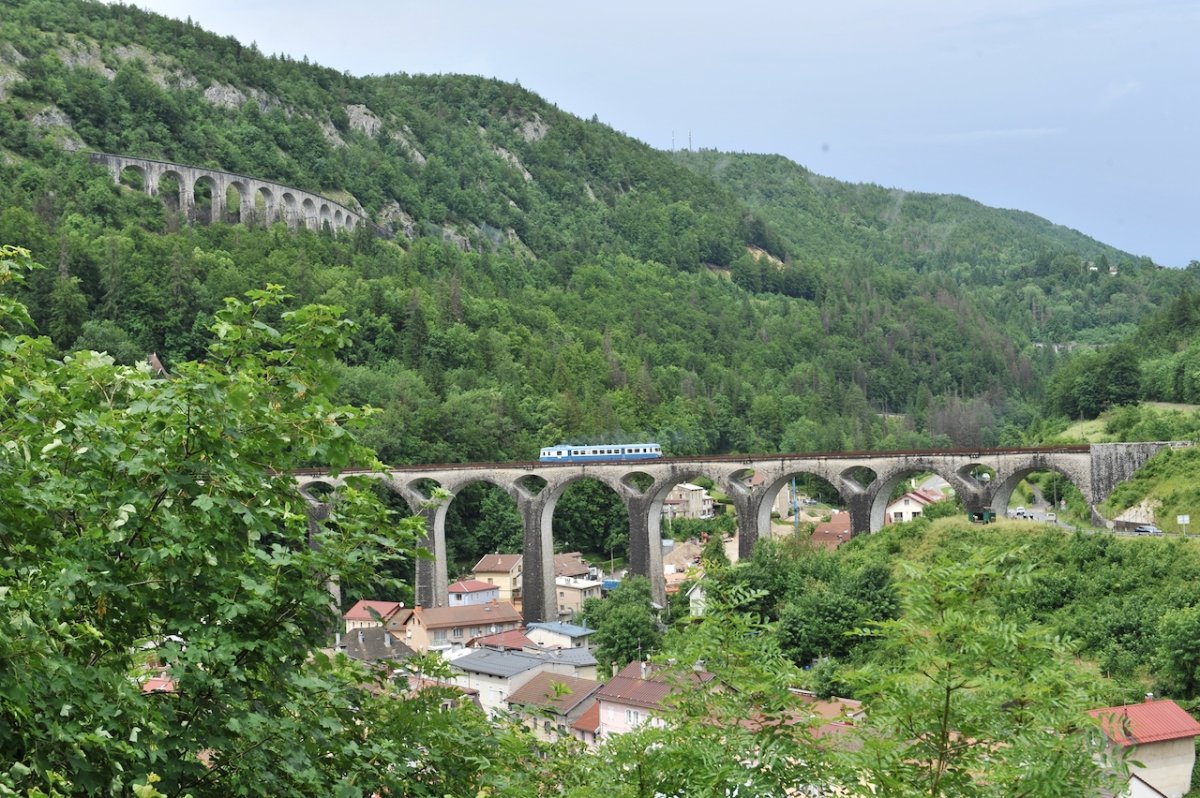
At risk of closure
On Sunday 15 June, X 2816 preserved by l’association L’Autorail X 2800 du Haut-Doubs is seen leaving Morez with a Train de la fête des Pères special from L'Hôpital du Grosbois and Besançon-Viotte to Saint-Claude. Above the train can be seen a viaduct forming part of the Morbier loop on the section north of Morez to Besançon. The Ligne des Hirondelles is considered at risk due to low passenger numbers. Since closure of the section south of Saint-Claude to Oyonnax, travel to Bourg-en-Bresse and Lyon in no longer possible. Mobilisation against possible closure began on 31 May with a meeting and trip organised by Fnaut to raise awareness. The 18 viaducts and 36 tunnels are said to be in good order but €37 million needs to be spent on the track if safe running is to be ensured after 2027. Locals continue to press for a better service than today’s four A/R. Photo: Jean-Louis Poggi.
The once-daily extension of service from Clamecy to Corbigny was replaced by buses during June due to high temperatures affecting the track, rekindling fears of complete closure; the 30km/h speed limit makes it impossible to run the train within the current schedule which is a lodging turn for the crew.
Maintenance on the Saumur – La Roche-sur-Yon line, the central section of which has only one train daily, is now costed at €229 million, making it increasingly likely in the current economic climate that the route will be truncated at Thouars (limit of electrification) or Bressuire.
Canfranc commitment
Spanish infrastructure authority Adif will be the Maître d’Oeuvre for reconstruction of Somport tunnel following agreement with Nouvelle-Aquitaine région that Spain will undertake the work on both sides of the border. Visiting Canfranc on 9 June to mark reopening of the upgraded line from Zaragoza, Spanish transport minister José Antonio Santano said that a contract for the €93 million tunnel project would be awarded in the autumn. Renovation of the tunnel is being prioritised by Spain, he said, as part of the ‘step-by-step’ approach to reopening throughout between Canfranc and Pau, to which he had received a firm commitment from French transport minister Philippe Tabarot.
The Canfranero line from Huesca to Canfranc has been closed for two years for a major upgrade which has included provision for mixed broad and standard gauge. Track has been relaid with sleepers capable of accommodating a third rail so that there will be standard-gauge throughout from Pau to Zaragoza and the nearby Plaza international freight logistics hub. €180 million has been spent on the route from Zaragoza, with work on the Jaca – Canfranc section costing €45.6 million. Journey time between Huesca and Canfranc has been cut by 30min to 2h 35.
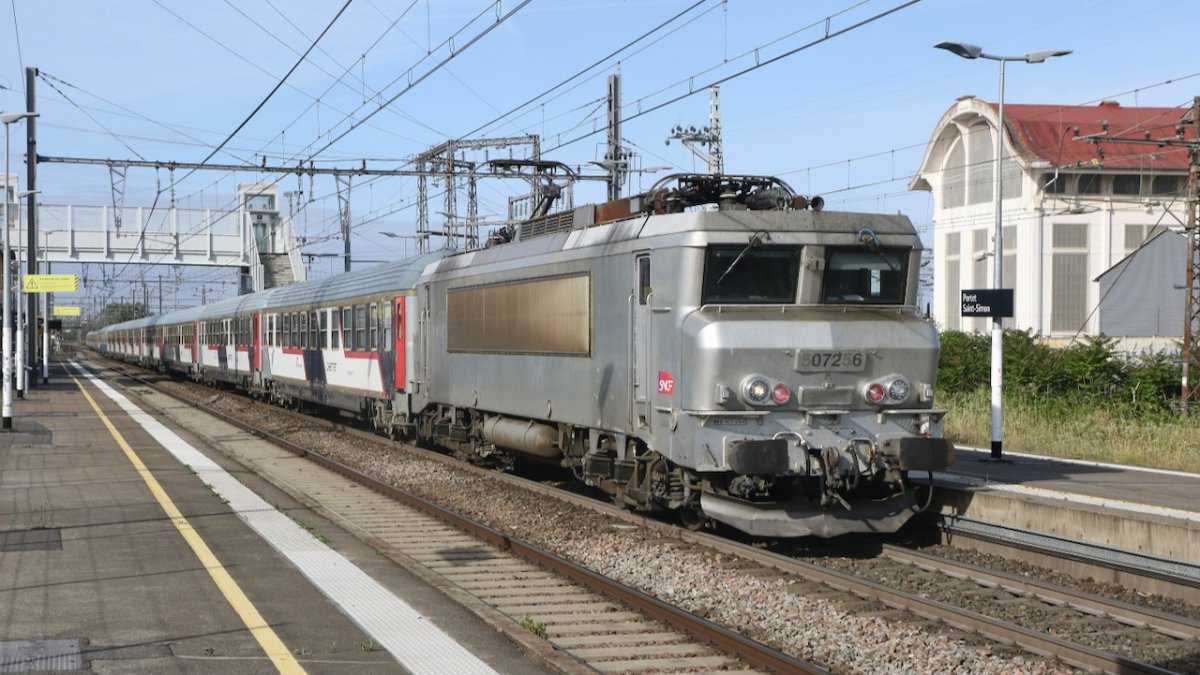
Pilgrims' Progress
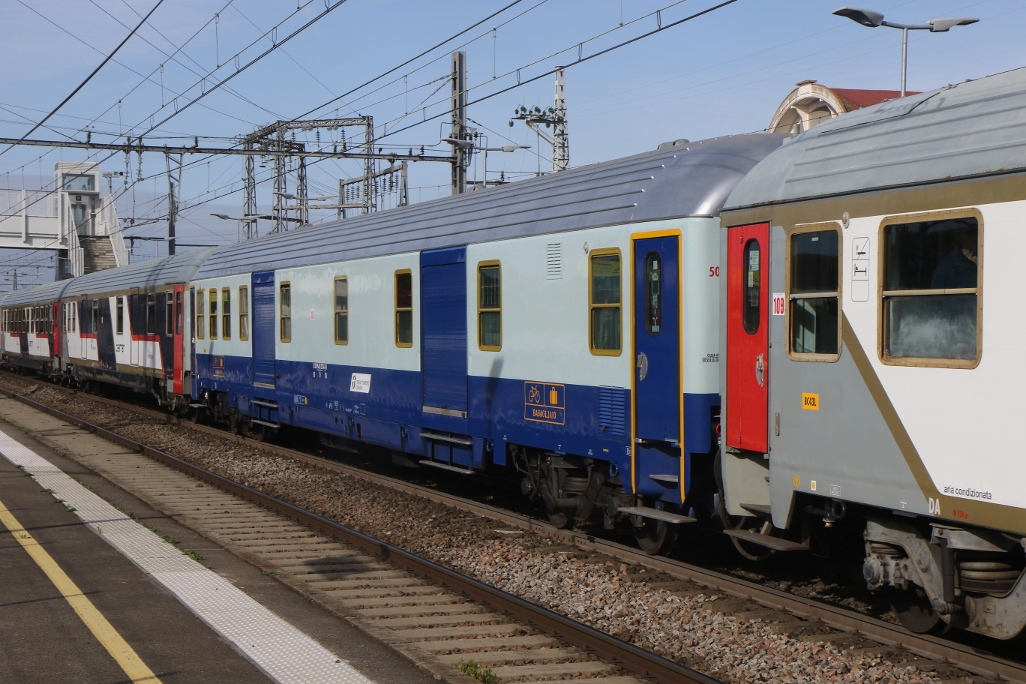
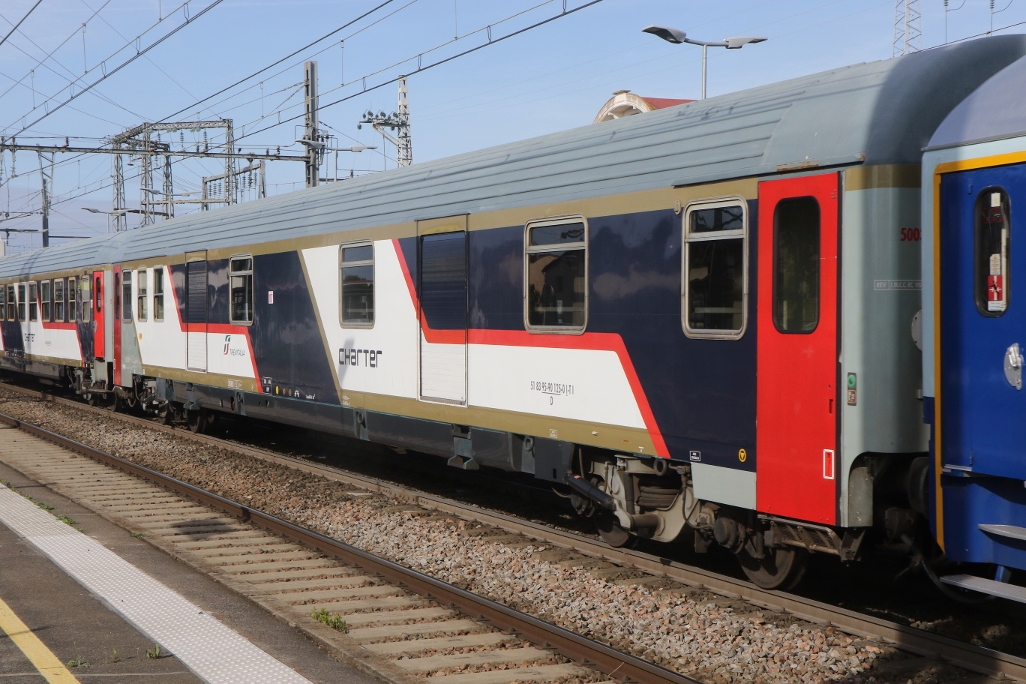
With the steady reduction in locomotive-hauled trains, the variety of rolling stock diminishes. Pilgrims’ charters to Lourdes still include a interesting range of vehicles. On 27 May, 29956 Lourdes – Padua (east of Venice) formed of Trenitalia Charter rolling stock is seen passing through Portet-Saint-Simon on the outskirts of Toulouse hauled by BB 7256. Included in the 15-vehicle consist were at least four different types of vehicles, shown above and below. In clockwise order: TTI-liveried Fourgon 51 83 95-70 227-8 I-Tl, Fourgon 51 83 95-90 125-0 I-TI, Ambulance 61 83 89-70 001-3 I-TI and Coach 61 83 50 70 603-1 I-TI. Photos: Georges Turpin.
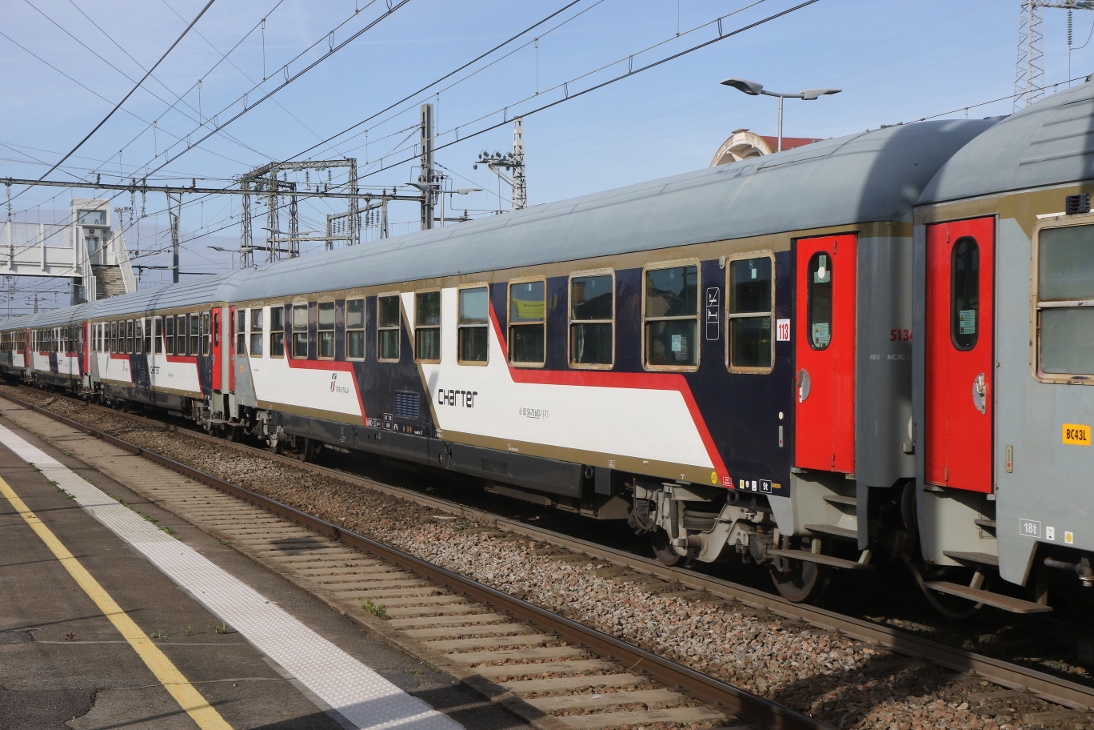
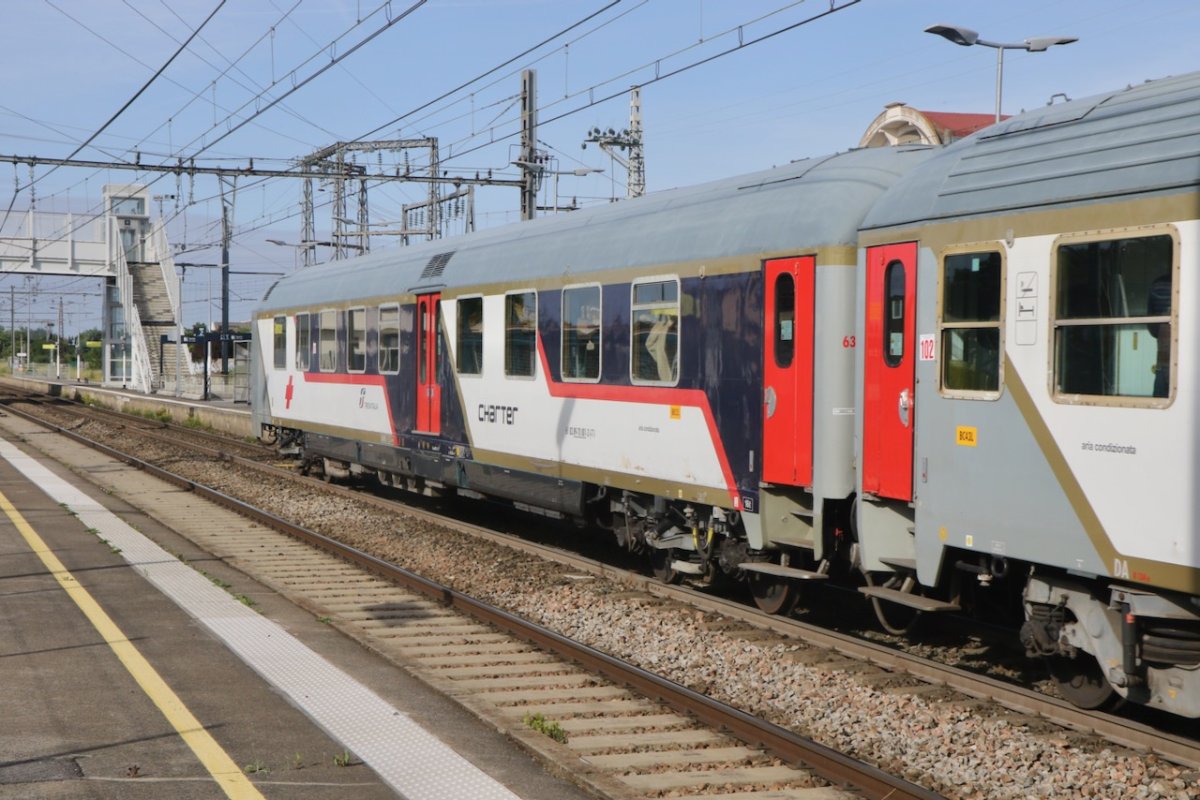

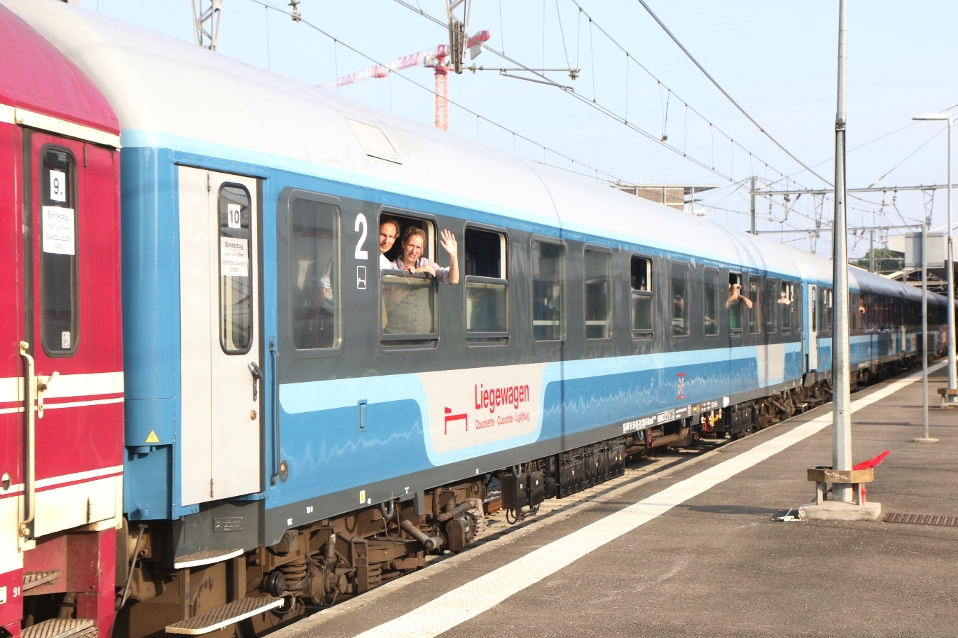
On 12 June a returning charter 27898 Lourdes – Osnabrück (Germany) consisted of a mix of German and Slovakian registered vehicles. The 15 coach train, headed by BB 7250, had encountered difficulties climbing Capvern taking over three and a half hours to cover the 179km from Lourdes to Toulouse. Unusually the train ran to Raynal rather than the locomotive running around in the station. Included in the consist (clockwise from top left) were WGmk D-Euro 56 80 89-80 037-5, Bocmh SK-GfF 51 56-05 70 520-8, WGm D-Euro 56 80 89-80 009-4 and Bcmh SK-GfF car 51 56 05-70 511-7. Photos: Georges Turpin.
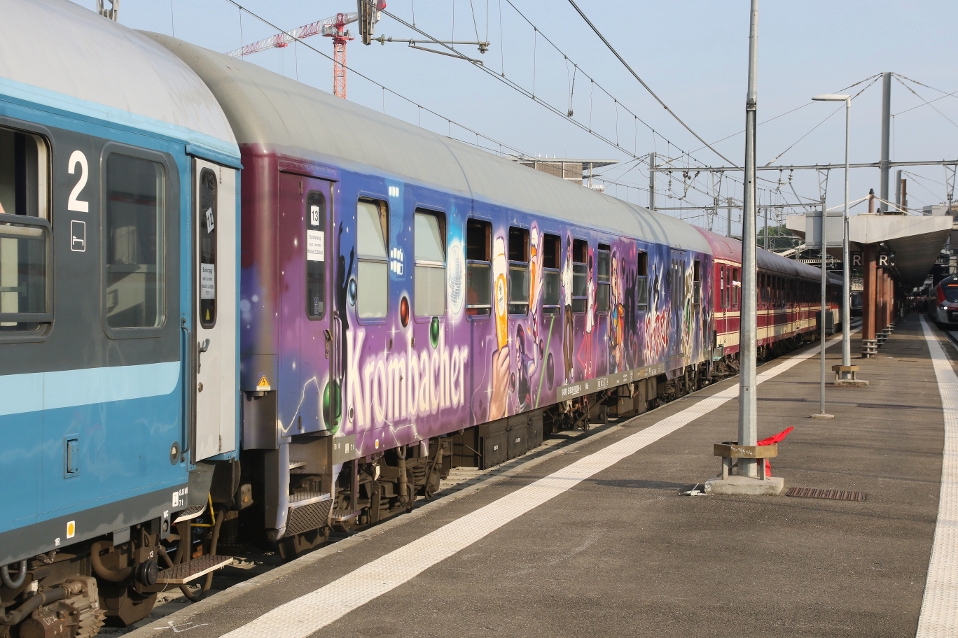
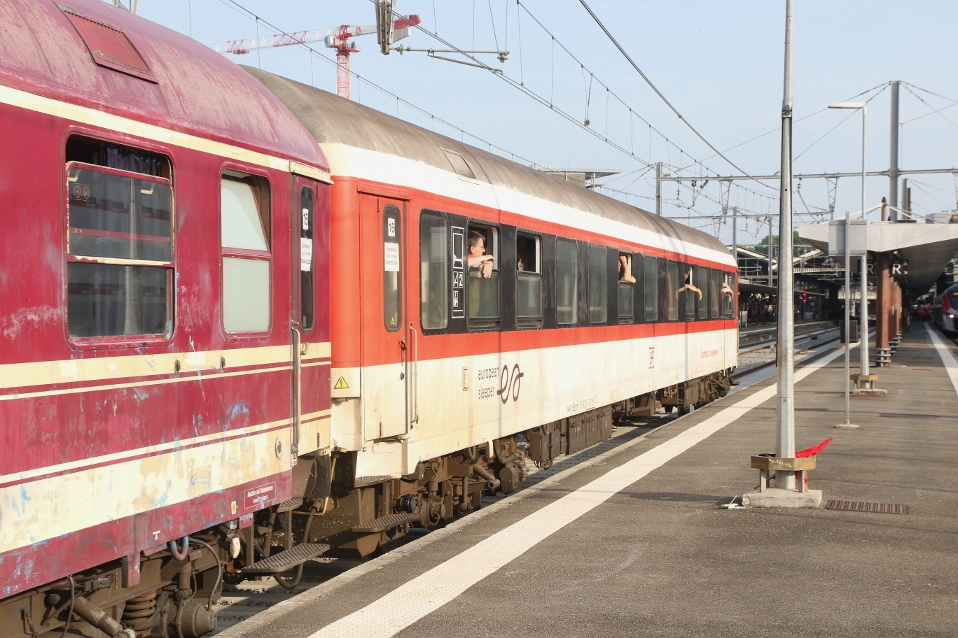
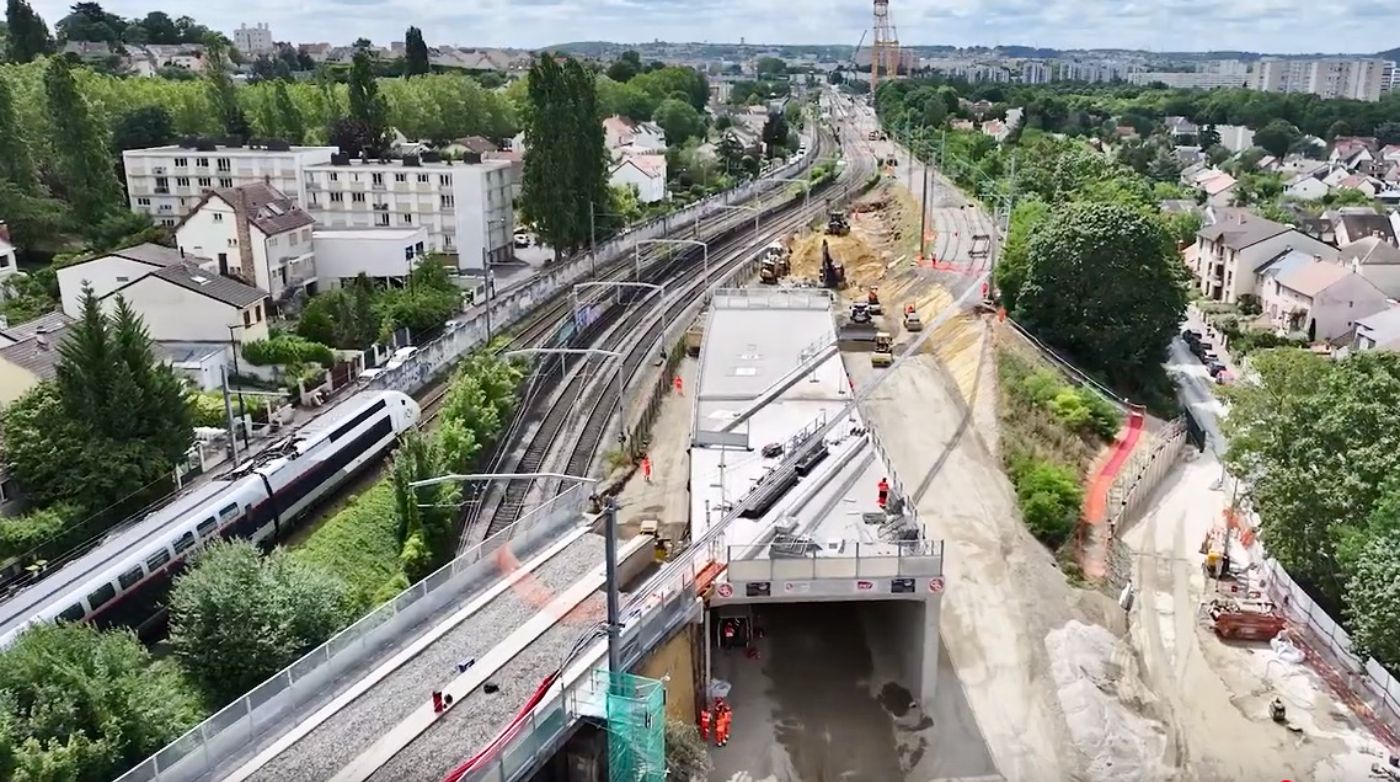
Massy – Valenton Interconnexion
A second bridge (see diagram) for Line B tracks, completed last year but not yet in use, will free up the original structure to accommodate a new eastbound track for TGVs, eliminating the existing flat junction with Line C and raising speed from 60 to 100km/h. When double track is available throughout the west-east corridor, SNCF intends to run more inter-regional trains and to revive its plan for TGV platforms at Pont-de-Rungis-Orly Airport. With Île-de-France having fewer TGV stations by population than other régions, estimates suggest stopping TGVs here would attract 3.6 million passengers a year, some interchanging from flights and metro Line 14 but mostly residents of southeast Paris for whom Massy is inconvenient.
Major work during 2023-24 saw construction of a new bridge to take Line C tracks over Line B, seen in this view looking west towards Massy with a TGV passing on the single-line section of the Interconnexion. This summer’s work centres on shifting Line B tracks several metres to the north so as to pass beneath Line C in the new structure, vacating the old bridge for use as a burrowing junction to accommodate eastbound TGVs. Trains on both RER lines will be disrupted between 12 July and 27 August. Photo and diagrams: SNCF Réseau.
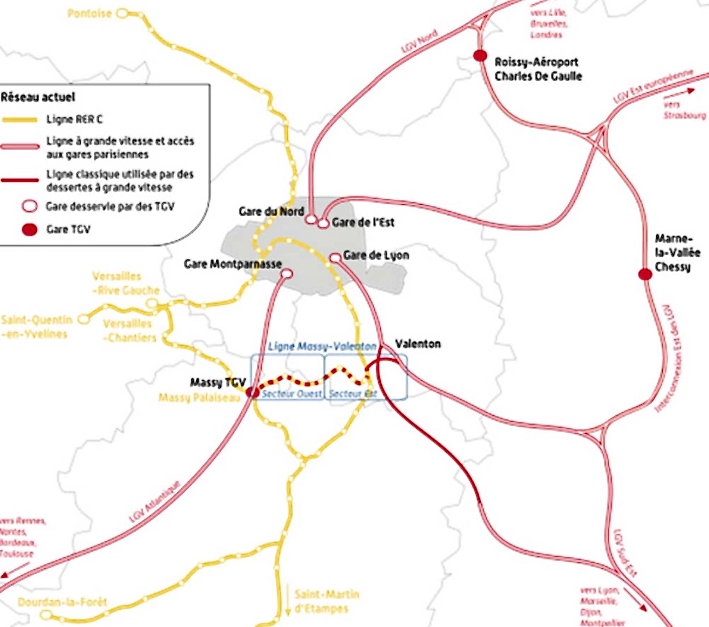
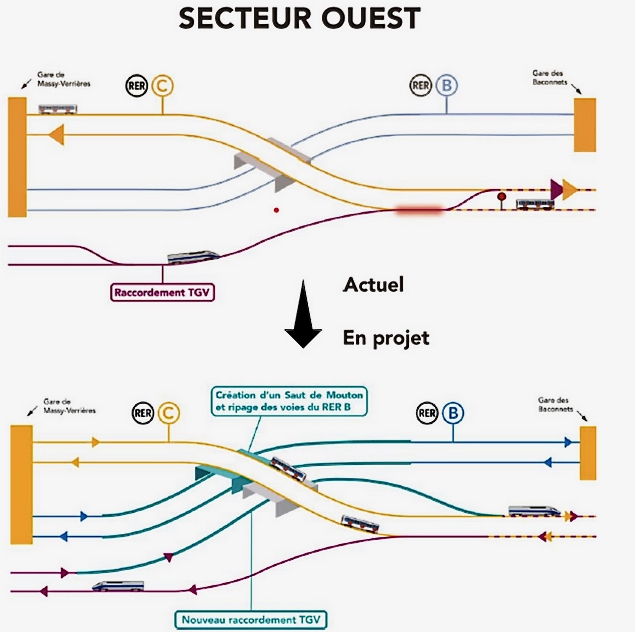
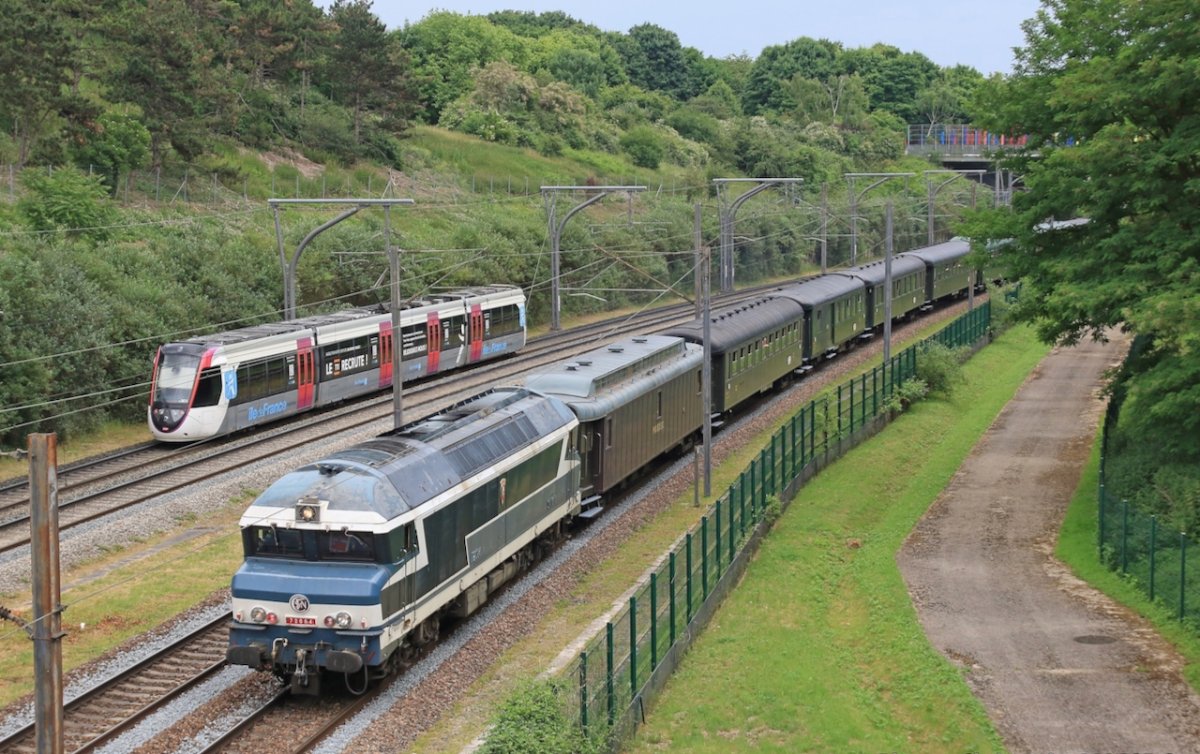
On Saturday 31 May, Pacific Vapeur Club at Sotteville organised the Grande Ceinture Parisienne railtour from Motteville. Originally scheduled for CC 65512, ongoing axle profile problems saw CC 72084 substituted instead. The outward route was initially to Versailles Chantiers (with option of visiting the Palace). From here the tour proceeded to Creil via Bièvres, Massy-Palaiseau, Longjumeau and Persan Beaumont. The return from Creil to Versailles was via Chantilly Gouvieux, Orly Ville and Massy-Palaiseau. Seen above passing Georges Valbon Park between the Dugny-La Courneuve and Stains-La Cerisaie stops along the Tangentielle Nord (T11 Express). Photo: Christophe Masse.
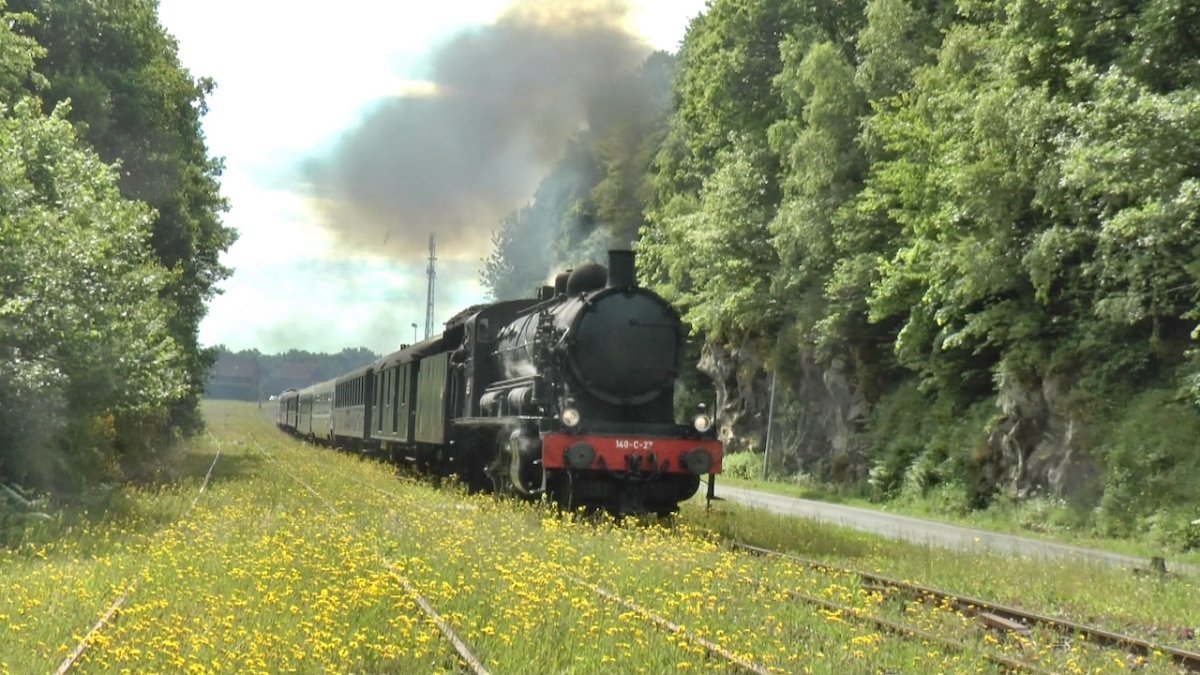
140 C 27 continued its summer programme on Saturday 31 May with a Thermal Express tour from Clermont-Ferrand to La Bourboule where the town was en fête to celebrate the 125th anniversary of the Funiculaire de Charlannes which ran until 1958. Seen above amongst the flowers on departure from Volvic. Photo: Alan Allbuary.
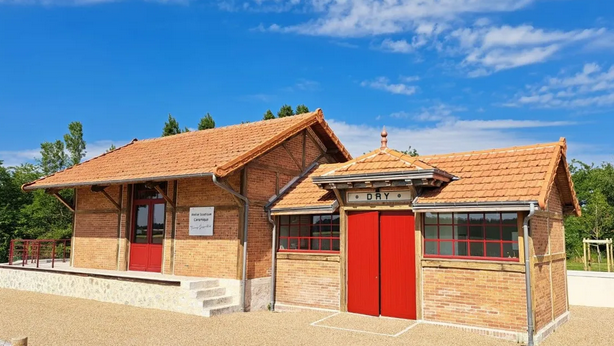
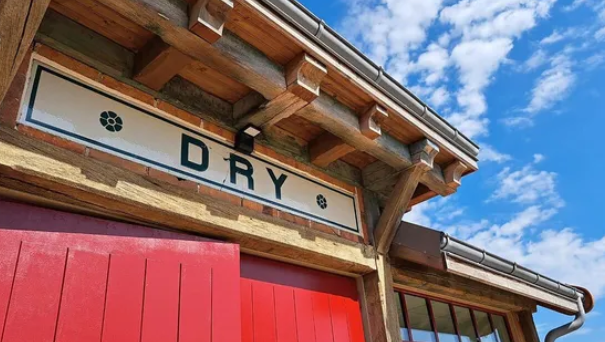
Dry. The station in this Loiret village southwest of Orléans on the former Tramways Électriques de Loir-et-Cher has a new lease on life after renovation at a cost of €180,000. One of three remaining and closed in 1934, the building had been used as a ceramics workshop before lying derelict for 15 years. Now restored, it houses a pottery once again. Photo: ©Radio France/CdaC.
Livradois-Forez. CF du Haut-Forez, which operates the La Chaise-Dieu to Estivareilles portion of the Livradois-Forez Railway, has been closed since the end of 2022 due to defective track. Replacement of 2,000 sleepers has been completed between Craponne-sur-Arzon et La Chaise-Dieu, allowing tourist trains to operate again from 22 June.
Cajarc. Strong feelings have been aroused in this Lotois commune over the presence of Picasso autorail X 3825 on the station site, apparently in contravention of local planning regulations. Work started in June converting the section between Cajarc and Larroque-Toirac (12km) into a voie verte, as part of the Lot Valley Voie Verte (see October 2024 News) and the autorail is considered an obstacle.
X 3825 was part of the QuercyRail fleet that operated tourist trains on
the former Cahors – Capdenac line (closed to passengers in 1980) until 2003. For some years it has been parked adjacent to the Musee du Rail located in the former goods shed at Cajarc. Its owner says he was mislead into believing approval would be granted for the autorail to become a restaurant. He said “the commune of Cajarc has done everything to sabotage my project”. The dispute is to be settled in the Cahors regional court in December.

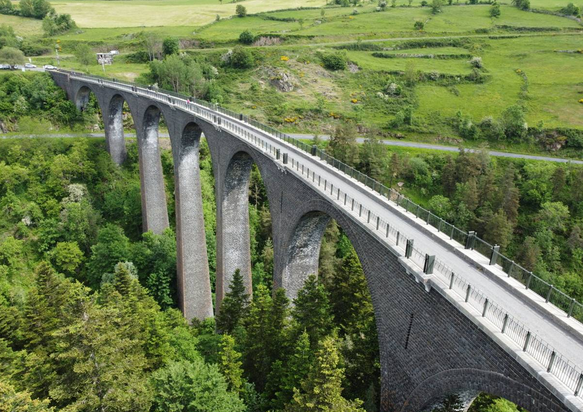
Transcévenol. On 22 June the centenary was commemorated of Recoumene viaduct, a structure on the projected 93km line from Le Puy-en-Velay to Lalevade-d’Ardèche, begun in 1911 but only partially completed and never opened. The project was abandoned in 1931. Photo: L’Éveil de la Haute-Loire/LC.

Velay Express. On 8 June Billard autorail No 313 derailed between Tence and Le Chambon-sur-Lignon. The 15 passengers were unhurt and able to walk the 2km to Chambon station where the steam-hauled train from Raucoules was unable to proceed. Passengers were eventually taken back to Raucoules by bus.
Photo: La Commère43.
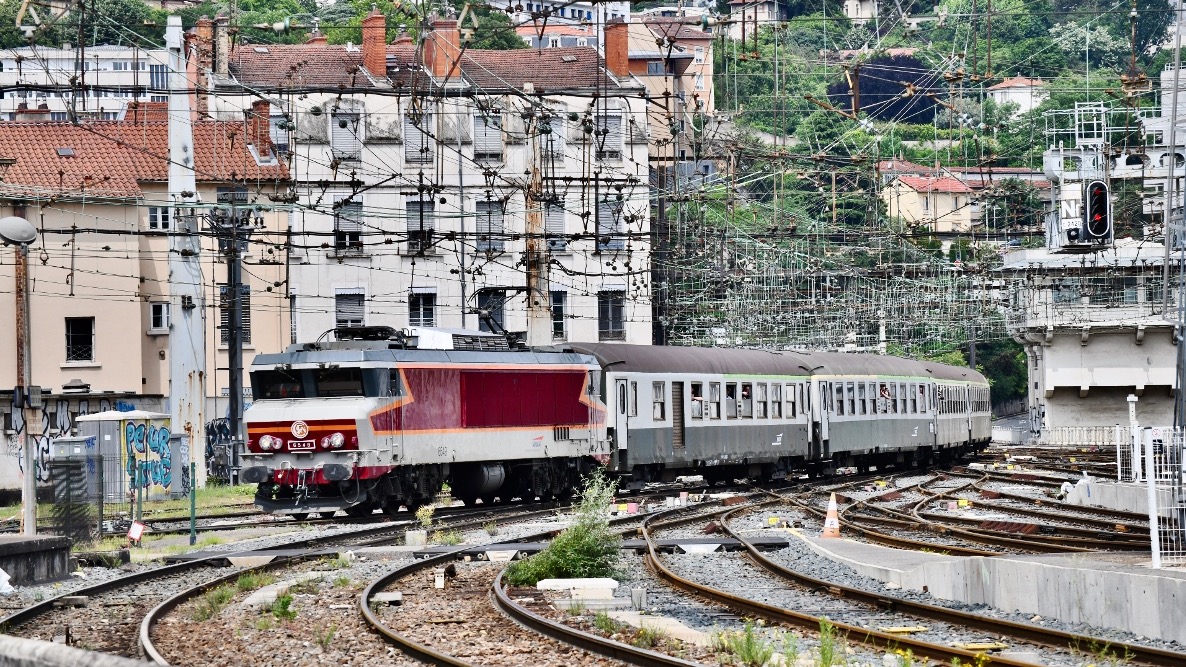
On 5 June APMFS organised a private charter for a group of Dutch enthusiasts consisting of CC 6549 and four UIC coaches. Departing from Chambéry it travelled to Lyon via Ambérieu and Dijon, returning via St Pierre d'Albigny. Seen above approaching Lyon Perrache under a latticework of OHL. Photo: Pierre Julien.
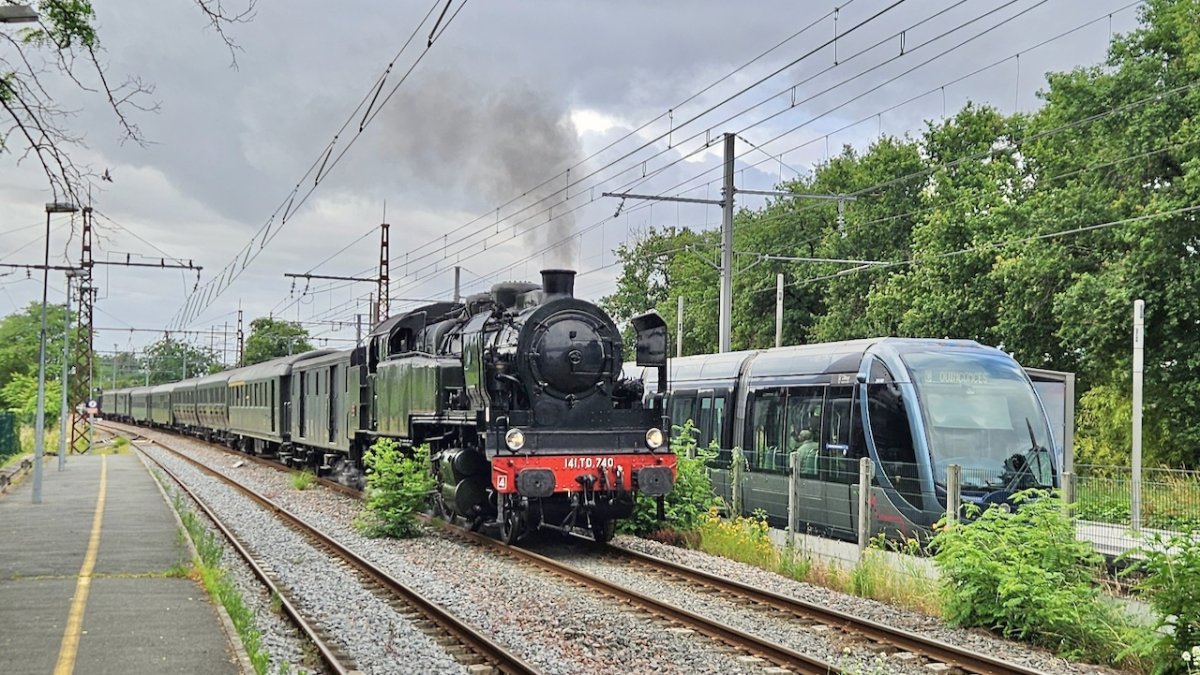
Soulac-sur-Mer’s 1900 festival of music and culture saw 141 TD 740 and vintage coaches of Conservatoire Ferroviaire Territoires Limousin Périgord on a special from Bordeaux (08.30) on 7 June bringing visitors in period costume. BB 69421, now numbered 040DG-421, brought up the rear. TERs Bordeaux – Le Verdon at 09.57 and 12.17 return were cancelled due to track capacity issues. The special is seen calling at Blanquefort (tramway Line C terminus) at 09.10.
Urban Rail
Paris. RATP’s new maintenance centre for MF19 trains was opened at the former Line 12 depot at Vaugirard (20th arr) on 23 May. Designed for both new-generation and older stock, the site has robots to move heavy components around and a pneumatic distribution system that brings parts from stores to worksite within 15min. The development includes 235 residential units, partly reserved for RATP staff.
Work started on 16 June on the 10km extension of T13 from Lisière Periere (Saint-Germain-en-Laye) to Poissy and Achères, some 3km of which will use Grand Ceinture alignment. Opening in 2028, there will be four stops including interchanges at Poissy (RER Lines A/E) and Achères-Ville (RER Line A and Transilien Line L).
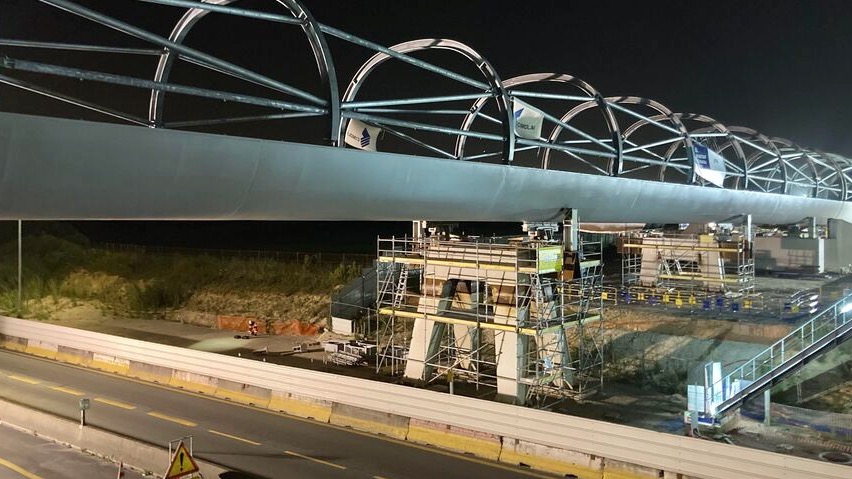
GPE. Mid-May saw positioning of a 200m-long viaduct which will carry Line 17 over the A1/A3 motorways between Gonesse and Aulnay-sous-Bois. This is on the middle section of the route, scheduled to open between Le Bourget and Parc des Expositions in 2028. Photo: Le Parisien/AC.

At Chelles-Gournay on Line 16, Société des Grands Projets held an open day on 14 June to show off the station shell, with an immersive tour, music, dance, children’s events and a barbeque. This section of Line 16 should open between Clichy-Montfermeil and Noisy-Champs in 2028. Photo: SGP.
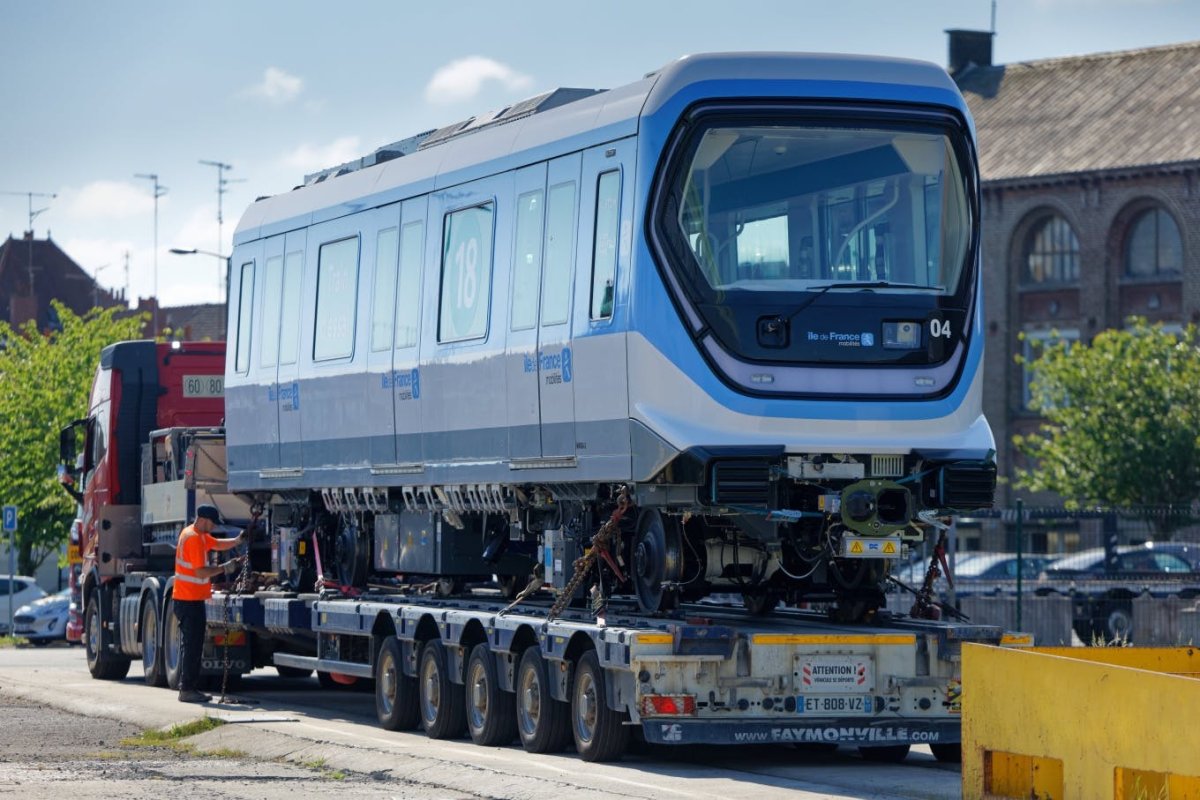
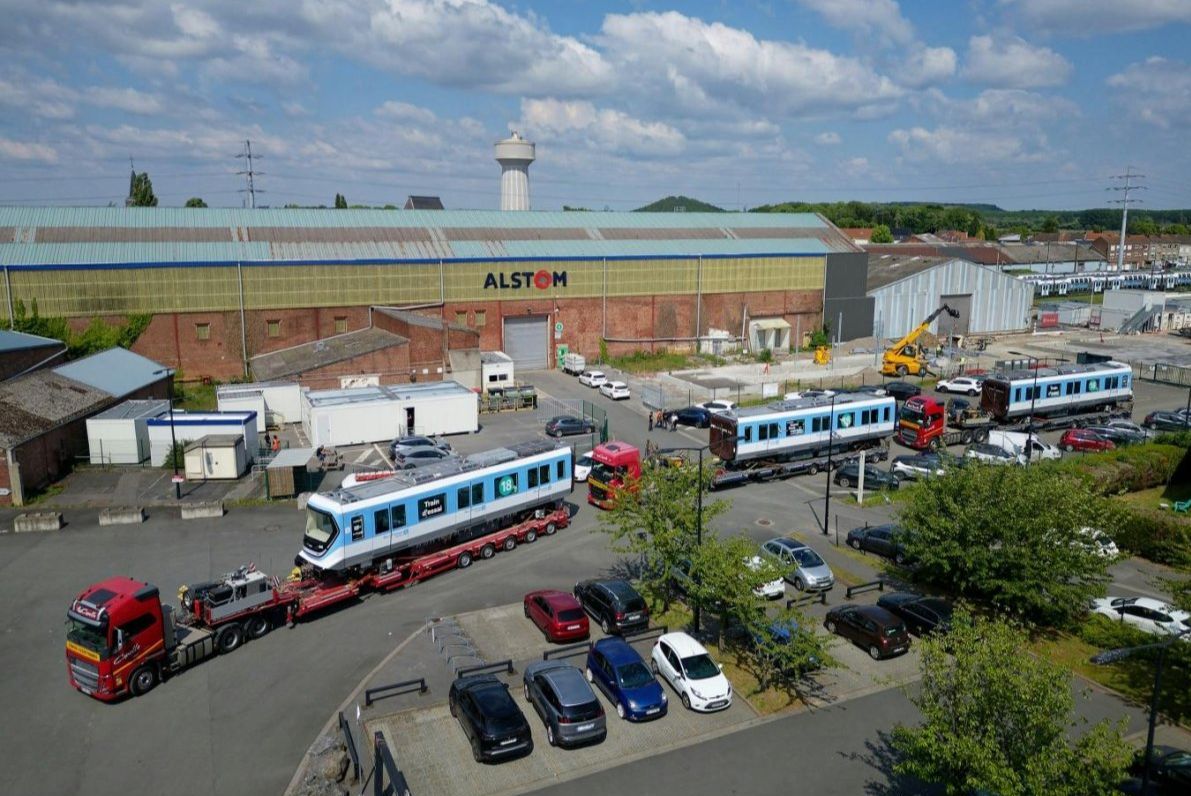
The first cars for GPE Line 18 arrived at Palaiseau depot at the end of May on low-loaders from Alstom’s Valenciennes plant. They were presented to the press on 17 June. Running trials will start at the end of the year, when 10 of the 15 three-car sets will have been delivered. As reported last month, Société des Grands Projets now suggests that the central section of Line 18 between Massy-Palaiseau and Christ de Saclay might be the first GPE line to open, in ‘fourth quarter’ 2026. Line 18 will link Versailles-Chantiers with Aéroport d’Orly, 35km, 10 stations. Trains will run at 90sec intervals at peak times, with a maximum speed of 100km/h. Local officials published a report on 22 June outlining an eastward extension from Orly to Boissy-Saint-Léger, nine stations; a ‘horizon’ project unlikely to be achieved before 2040. Photos: Alstom/SD.
Roubaix. After preparatory work during May, the Mongy tramway to Lille is closed from 7 July to 31 August for track relaying and modernisation prior to next year’s arrival of 24 Alstom Citadis cars. The fourth round of public consultations for the planned Roubaix-Tourcoing tramway (see September 2024 News) ended on 3 June with confirmation of the 22km route and an announcement that opening would be postponed until 2033 at the earliest.
Tours. The Lignes2Tram project was declared to be of public utility on 13 June, paving the way for preliminary work to start this month. T2 will link La Riche and Chambray-lès-Tours (12.5km, 22 stops). Opening is planned for 2028; construction cost is €570 million.
Monaco. France will not support the idea of a dedicated metro line from Nice to Monaco, as proposed by the maire of Nice, or agree to the proposed €1.2 billion ‘express metro’ link from the Principality to a 3,500-vehicle parking site over the border at Eze. Transport minister Philippe Tabarot believes the new 15min interval TER service from Nice and other Improvements to the existing railway should provide sufficient extra capacity for the present.
Toulouse. At the beginning of June, construction work on the third metro line resulted in the closure of the corridor that provided quick access to the Marengo metro station from the adjacent Toulouse Matabiau station.
For the next year, passengers will have to walk via the exterior of the station. The journey takes about ten minutes for someone who can walk well and isn't burdened with luggage. There will also be a shuttle bus that connects the station to the metro every 15 minutes. Photo: Georges Turpin.
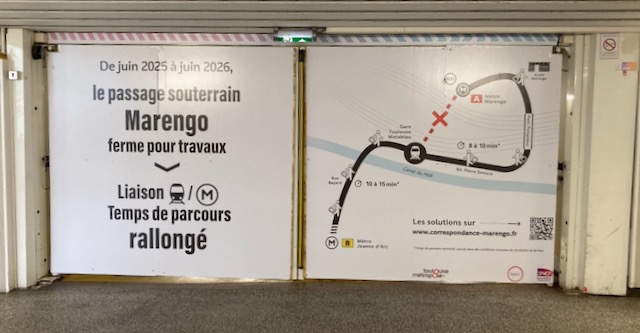
Additions to FRS Photographic Archive during June 2025
To Photographic section
- Images of a Royal visit to France in August 1855 have been added to Folder 4
- A selection of drawings published by Loco Revue under the title 'Signaux & Installations Fixes' has been added to Folder 2
- A selection of short articles that appeared in Loco Revue under the title 'PhotoDocs' has been added to Folder 7
- Added LVDR 1451/July 1974 “Z.7001”
- Added LVDR 2072/Dec 1986 “Musee d’Orsay”
- SNCF Region Nord - Transport des Voyageurs et des Bagages - 7 Octobre 1946
- SNCF Region Nord - Fascicules-Horaires No. 2.26 - 7 Octobre 1946
- SNCF Region Nord - Fascicules-Horaires No. 2.15 - 7 Octobre 1946
- CdF du Nord - Chefs de Gare et Chefs de Station - Règlement général - Novembre 1935
- SNCF Region Sud-Ouest - Fascicules-Horaires No. 4.01 - 1 Juin 1958
- SNCF Region Sud-Ouest - Fascicules-Horaires No. 4.35B - 1 Juin 1958
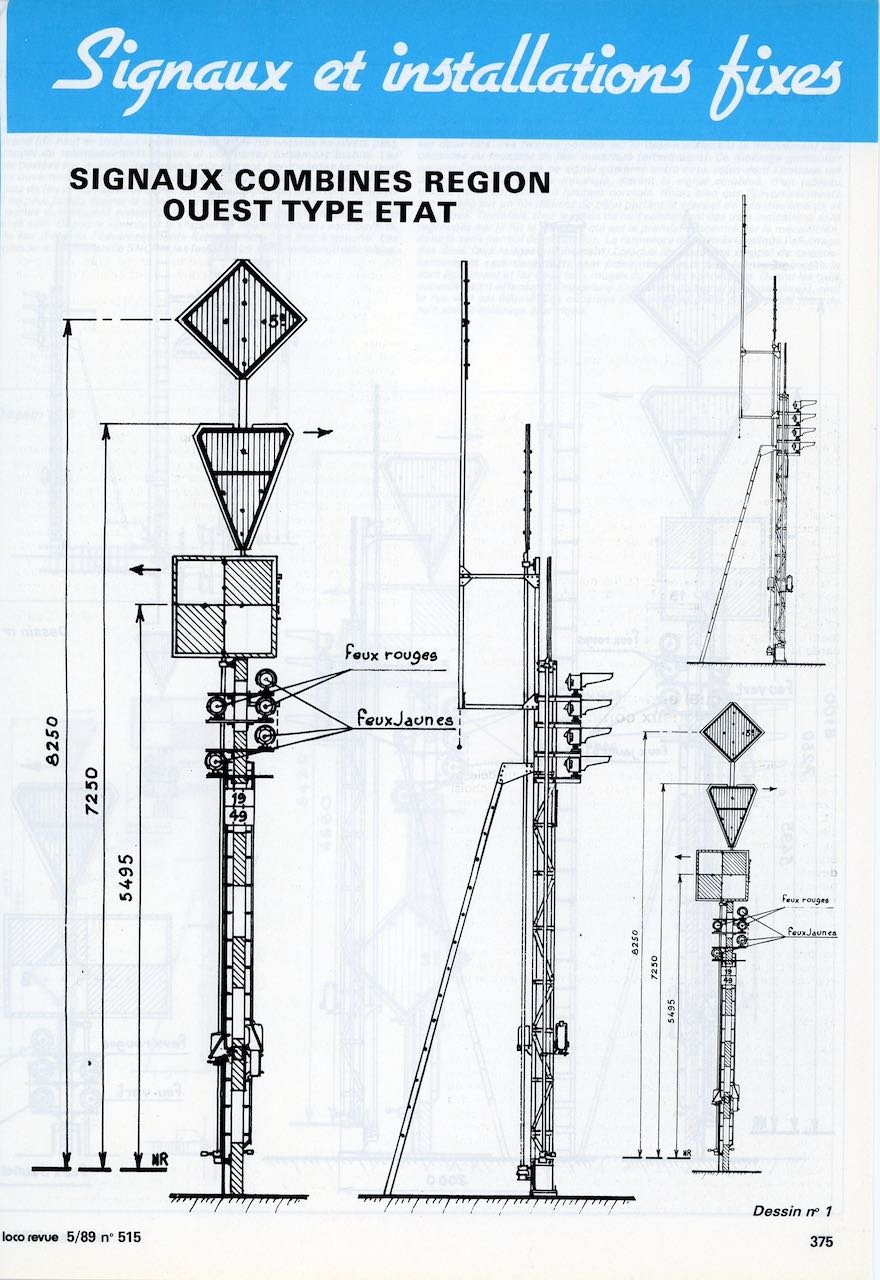
© Peter Lovell & Chris Bushell. The French Railways Society 2025. With thanks to Georges Turpin, Christophe Masse, Didier Delattre, Jean-Louis Poggi, Pierre Julien and Alan Allbuary.
